This site is made possible by member support. ❤️
Big thanks to Arcustech for hosting the site and offering amazing tech support.
When you buy through links on kottke.org, I may earn an affiliate commission. Thanks for supporting the site!
kottke.org. home of fine hypertext products since 1998.
Entries for September 2016
A quick perspective on how big some things are



Kevin Wisbeth, who runs a new YouTube series called A Quick Perspective that compares things like the Space Shuttle and the Megalodon (biggest shark ever) to more familiar objects like buildings and cars. Here’s the Shuttle video:
Wisbeth shared some comparison images deemed unworthy for full videos on Imgur. The examples I’ve included above are a) the Titanic resting comfortably on the deck of a US aircraft carrier,1 b) the Death Star floating just over Florida, and c) the Sears Tower resting at the bottom of one of the world’s largest mines.
Reminds me of BERG’s now-defunct BBC Dimensions project and Manhattan Elsewhere. (via colossal)
And aircraft carriers aren’t even the biggest ships out there. Here’s a photo of the Titanic compared to the Allure of the Seas, one of the largest cruise ships in the world.↩
Born to be Mild: The Dull Men’s Club
Born to be Mild is a short documentary about The Dull Men’s Club, an online community of men wishing to escape the hurly-burly of everyday life and just be ordinary.
Whether you’re crazy for roundabouts, addicted to photographing mailboxes, have the world’s largest collection of British milk bottles, or you’re a dull man with pretty much any sort of hobby that induces bafflement and yawns in friends and acquaintances, there’s a club just for you. A drolly cheerful celebration of the very ordinary, Born to be Mild explores the uncommon hobbies practiced by the members of the Dull Men’s Club — an online community that connects ‘dull men, and women who appreciate dull men’.
The group’s “greatest accomplishment”, listed on their about page, is:
Remaining dull in spite of the ever-increasing pressures from advertising, the media, and elsewhere to change.
In a recent piece in the NY Times Magazine, Nicholson Baker wrote about dullness:
That’s the extremely interesting thing: Everything is interesting. Potentially. Sometimes it may not seem so. You may think a certain thing is completely without interest. You may think, or I may think, eh, dull, boring, heck with it, let’s move on. But there is someone on this planet who can find something interesting in that particular thing. And it’s often good to try. You have to poke at a thing, sometimes, and find out where it squeaks. Any seemingly dull thing is made up of subsidiary things. It’s a composite — of smaller events or decisions. Or of atoms and molecules and prejudices and hunches that are fireflying around in unexpected and impossible trajectories. Everything is interesting because everything is not what it is, but is something on the way to being something else. Everything has a history and a secret stash of fascination.
The Dull Men’s Club actually seems to be the Odd Objects Collector’s Club. I could get into milk bottles and roundabouts. What about the truly dull, who don’t collect anything and just watch the news on TV all day?
In-N-Out Burger is overrated
While I don’t quite agree, I did enjoy reading Andy Kryza’s take on In-N-Out: In-N-Out Is Crushingly Disappointing.
This is your basic, salty, flat-grilled burger that you can get absolutely anywhere. If somebody gave me a blind taste-test between this and most other fast-food burgers, I might be able to distinguish In-N-Out, but it’s not guaranteed. It’s highly generic, as if culled together from a series of stock photos: bun, burger, watery lettuce, and a slice of tomato. Sure, you can get it Animal Style, but be honest: Animal Style sauce tastes like Whole Foods’ version of Big Mac sauce, except not as good.
And as Anil Dash said on Twitter:
it’s the best burger for people who eat a burger for the vegetables
They are in different leagues — an In-N-Out cheeseburger is $2.35 while a Shackburger goes for $5.29 — so a comparison is unfair, but in my mind, that extra $3 at the Shack buys you a lot of flavor. Still, as Kryza says, next time I’m in CA, I’m gonna get myself a burger at In-N-Out.
Epoch, a new album from Tycho
A cool brace from Tycho this week. First was the chill Burning Man set and now a brand-new album called Epoch. My Friday is allllll set.
Man films annual personal report from 1977 to 2011
In 1977, the Voyager space probes were launched from Earth to explore our solar system. That same year, Sam Klemke began a project to document his life on video, and in 2011, he made a video of 35 years of annual greetings/status reports. This video resulted in a documentary film, Sam Klemke’s Time Machine.
Beginning decades before the modern obsession with selfies and status updates, Sam grows from an optimistic teen to a self-important 20-year-old, into an obese, self-loathing thirty-something and onwards into his philosophical fifties.
Finding yourself in fashion

Michael Chabon has written a great non-traditional boy-coming-of-age story about his son Abe, who, at 13, is obsessed with fashion.
It takes a profound love of clothes, and some fairly decent luck, to stumble on somebody who wants to converse about cutting-edge men’s fashion at a Rush concert, and yet a year before his trip to Paris, in the aftermath of the Canadian band’s last show at Madison Square Garden, Abe had managed to stumble on John Varvatos. Abe had spent that day leading his bemused minder on a pilgrimage through SoHo, from Supreme to Bape to Saint Laurent to Y-3, and now, ears still ringing from the final encore (“Working Man”), Abe reported in detail to Varvatos, with annotations and commentary, on all the looks he had seen downtown. When he was through, Varvatos had turned to Abe’s minder — a major Rush fan who was, of course, also Abe’s father — and said, “Where’d you get this kid?”
Read this all the way to the end…the perfect coda to the story.
Olly Moss designed the covers for the Harry Potter ebooks

I first ran across the work of designer Olly Moss several years ago, when he designed some super-simple alternate posters for iconic movies. He’s since worked on a whole bunch of great stuff, like Firewatch and posters for Studio Ghibli. Just the other day, while the kids and I were finding out what our Patronuses are,1 I discovered that Moss not only designed the cover of the forthcoming ebook of Fantastic Beasts and Where to Find Them but also did the covers for all seven of the Harry Potter ebooks.

Moss’ main technique, of combining two or more aspects of the story into a single image, is on full display in the Potter covers — the prison on a rock shaped like a dog for Azkaban, Voldemort as Harry’s scar for Hallows, and Dumbledore’s spell casting forming the pages of a textbook for Half-Blood Prince.
My Patronus is a badger. We also got sorted into our Hogwarts houses (Gryffindor for all three) and picked out wands (mine makes me sound like kind of an asshole). The sorting and wand choosing processes are basically personality tests. If you’ve never sat down with your kids and taken a personality test, I encourage you to do so. It was quite enlightening, not only seeing what they chose, but also seeing how they reacted to my choices and, especially, how I felt making those choices in front of them. I answered pretty honestly about who I think I am and what I would do in certain situations, but being watched so closely by two small humans who look to me to guide their choices in life was unsettling and caused me to second-guess some things. Like I said, enlightening.↩
100 greatest TV shows of all time
Rolling Stone polled actors, critics, producers, and showrunners about their picks for the greatest shows ever to air on TV and aggregated the responses. Some random results:
94. Jeopardy
87. Doctor Who
73. Transparent
57. Fawlty Towers
43. The Americans
27. Arrested Development
12. Game of Thrones
5. Seinfeld
That’s really high for Thrones, isn’t it? It’s no spoiler to say that the top two picks are The Wire and The Sopranos…you’ll have to click through to see which order they put them in. It’s been awhile since I’ve thought about what my list of favorite shows would look like, but just off the cuff, maybe (in no particular order):
The Wire, Seinfeld, Arrested Development, Transparent, Mad Men, Deadwood, The Simpsons, Iron Chef, Star Trek: The Next Generation, Mister Rogers’ Neighborhood, Doctor Who, The Americans.
A couple of those are definitely not great shows, but they are favorites all the same.
Data analysis of The Simpsons
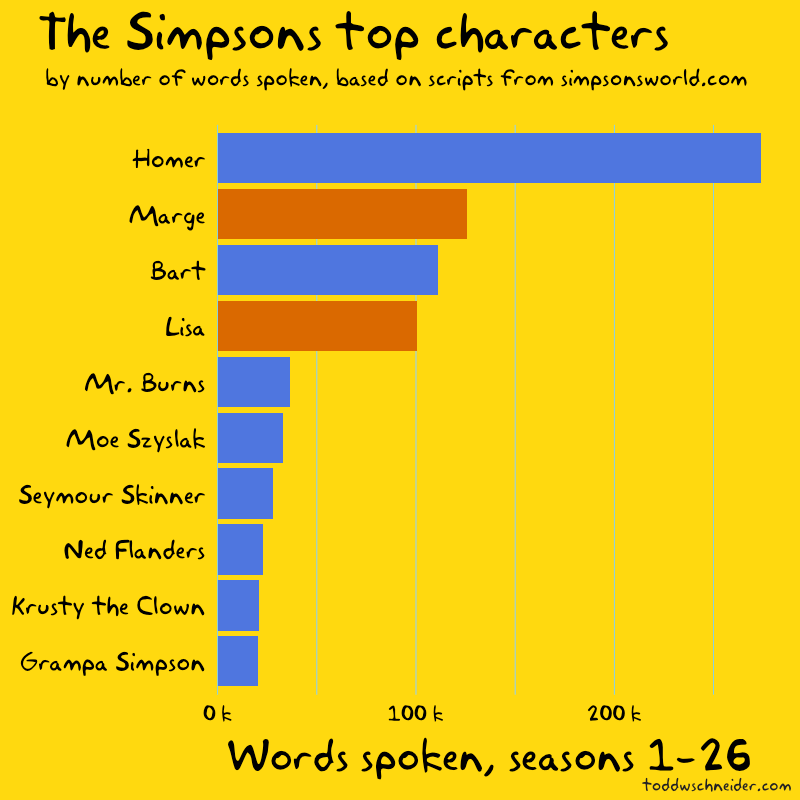
The Simpsons is the longest-running series in primetime TV history. The show’s 27 seasons hold much potential treasure for data scientists. Todd Schneider downloaded the scripts from every show and analyzed which characters spoke the most and where. The results reveal a heavy focus on Homer and a large gender imbalance in terms of dialogue.
The colors of the bars in the above graphs represent gender: blue for male characters, red for female. If we look at the supporting cast, the 14 most prominent characters are all male before we get to the first woman, Mrs. Krabappel, and only 5 of the top 50 supporting cast members are women.
Women account for 25% of the dialogue on The Simpsons, including Marge and Lisa, two of the show’s main characters. If we remove the Simpson nuclear family, things look even more lopsided: women account for less than 10% of the supporting cast’s dialogue.
See also Film Dialogue from 2000 screenplays, Broken Down by Gender and Age.
Trump paid the stereotype tax in the first debate
Jeet Heer writing for The New Republic: Clinton Proved Trump Is a Man You Can Bait in a Debate.
In her acceptance speech at the Democratic convention, Hillary Clinton called out Donald Trump memorably, saying, “A man you can bait with a tweet is not a man we can trust with nuclear weapons.” The insight that Trump is easy to provoke formed the core of Clinton’s successful strategy in the first debate on Monday, as she repeatedly incited the Republican nominee to both adopt an off-putting aggressive tone and to make a series of damaging self-admissions.
This reminded me of poker player Annie Duke’s explanation of how she used the gender stereotypes of her male opponents against them.
I figured it was part of the game that if somebody was at the table who was so emotionally invested in the fact that I was a woman, that they could treat me that way, that probably, that person wasn’t going to make good decisions at the table against me. So I really tried to sort of separate that out and think about it from a strategic place of, how can I come up with the best strategy to take their money because I guess, in the end, isn’t that the best revenge?
Trump sounds like he’s a combination of the angry and disrespecting chauvinists:
VEDANTAM: She says she divided the men who had stereotypes about her into three categories.
DUKE: One was the flirting chauvinists, and that person was really viewing me in a way that was sexual.
VEDANTAM: With the guys who were like that, Annie could make nice.
DUKE: I never did go out on a date with any of them, but you know, it was kind of flirtatious at the table. And I could use that to my advantage.
VEDANTAM: And then there was the disrespecting chauvinist. Annie says these players thought women weren’t creative.
DUKE: There are strategies that you can use against them. Mainly, you can bluff those people a lot.
VEDANTAM: And then there’s a third kind of guy, perhaps the most reckless.
DUKE: The angry chauvinist.
VEDANTAM: This is a guy who would do anything to avoid being beaten by a woman. Annie says you can’t bluff an angry chauvinist. You just have to wait.
DUKE: What I say is, until they would impale themselves on your chips.
Although I suspect his chauvinism is only part of his poor debate showing…his insecurity is off the charts as well.
A trailer for David Lynch’s Return of the Jedi
Did you know that George Lucas approached David Lynch about directing Return of the Jedi? After a visit to Lucas’ studio described here by Lynch, Lynch turned Lucas down pretty quickly. But what might have been, huh? Well, this fan-made trailer gives us a taste of a Lynch-helmed Star Wars movie. (via one perfect shot)
Meet the Nano Sapiens

In a 1959 talk at Caltech titled There’s Plenty of Room at the Bottom, Richard Feynman outlined a new field of study in physics: nanotechnology. He argued there was much to be explored in the realm of the very small — information storage, more powerful microscopes, biological research, computing — and that that exploration would be enormously useful.
I would like to describe a field, in which little has been done, but in which an enormous amount can be done in principle. This field is not quite the same as the others in that it will not tell us much of fundamental physics (in the sense of, “What are the strange particles?”) but it is more like solid-state physics in the sense that it might tell us much of great interest about the strange phenomena that occur in complex situations. Furthermore, a point that is most important is that it would have an enormous number of technical applications.
In a reaction to Elon Musk’s plan to colonize Mars, David Galbraith suggests there might be plenty of room at the bottom for human civilization as well. Don’t colonize Mars, miniaturize humanity. Create nano sapiens.
If we think of this as a design problem, there is a much better solution. Instead of expanding our environment to another planet at massive cost, why wouldn’t we miniaturise ourselves so we can expand without increasing our habitat or energy requirements, but still maintain our ability to create culture and knowledge, via information exchange.
The history of information technology and the preservation of Moore’s law has been driven by exactly this phenomenon of miniaturization. So why shouldn’t the same apply to the post technological evolution of humankind as it approaches the hypothetical ‘singularity’ and the potential ability for us to be physically embodied in silicon rather than carbon form.
When humans get smaller, the world and its resources get bigger. We’d live in smaller houses, drive smaller cars that use less gas, eat less food, etc. It wouldn’t even take much to realize gains from a Honey, I Shrunk Humanity scheme: because of scaling laws, a height/weight proportional human maxing out at 3 feet tall would not use half the resources of a 6-foot human but would use somewhere between 1/4 and 1/8 of the resources, depending on whether the resource varied with volume or surface area. Six-inch-tall humans would potentially use 1728 times fewer resources.1
Galbraith also speculates about nano aliens as a possible explanation for the Fermi paradox:
Interestingly, the same rules of energy use and distance between planets and stars would apply to any extraterrestrial aliens, so one possible explanation for the Fermi paradox is that we all get smaller and less visible as we get more technologically advanced. Rather than favoring interstellar colonization with its mind boggling distances which are impossible to communicate across within the lifetimes of individuals (and therefore impossible to hold together in any meaningful way as a civilization) perhaps advanced civilizations stick to their home planets but just get more efficient to be sustainable.
Humans are explorers. Curiosity about new worlds and ideas is one of humanity’s defining traits. One of the most striking things about the Eames’ Powers of Ten video is how similar outer space and inner space look — vast distances punctuated occasionally by matter. What if, instead of using more and more energy exploring planets, stars, and galaxies across larger and larger distances (the first half of the Eames’ video), we went the other way and focused on using less energy to explore cells, molecules, and atoms across smaller and smaller distances. It wouldn’t be so much giving up human space exploration as it would be exchanging it for a very similar and more accessible exploration of the molecular and atomic realm. There is, after all, plenty of room down there.
Update: I knew the responses to this would be good. Galbraith’s idea has a name: the transcension hypothesis, formulated by the aptly named John Smart. Jason Silva explains in this video:
The transcension hypothesis proposes that a universal process of evolutionary development guides all sufficiently advanced civilizations into what may be called “inner space,” a computationally optimal domain of increasingly dense, productive, miniaturized, and efficient scales of space, time, energy, and matter, and eventually, to a black-hole-like destination. Transcension as a developmental destiny might also contribute to the solution to the Fermi paradox, the question of why we have not seen evidence of or received beacons from intelligent civilizations.
Before we get there, however, there are a few challenges we need to overcome, as Joe Hanson explains in The Small Problem With Shrinking Ourselves:
As it often seems in such matters, science follows science fiction here. In Kurt Vonnegut’s Slapstick (Amazon), the Chinese miniaturize themselves in response to the Earth’s decreasing resources.
In the meantime, Western civilization is nearing collapse as oil runs out, and the Chinese are making vast leaps forward by miniaturizing themselves and training groups of hundreds to think as one. Eventually, the miniaturization proceeds to the point that they become so small that they cause a plague among those who accidentally inhale them, ultimately destroying Western civilization beyond repair.
Blood Music by Greg Bear (Amazon) has a nano-civilization theme:
Through infection, conversion and assimilation of humans and other organisms the cells eventually aggregate most of the biosphere of North America into a region seven thousand kilometres wide. This civilization, which incorporates both the evolved noocytes and recently assimilated conventional humans, is eventually forced to abandon the normal plane of existence in favor of one in which thought does not require a physical substrate.
James Blish’s short story Surface Tension tells the tale of microscopic human colonists. (via @harryh, @mariosaldana, @EndlessForms, @vanjacosic, @chumunculus)
Update: For some years, director Alexander Payne has been working on a film called Downsizing:
“Downsizing,” after all, starts off in Norway and takes place in a not-too-distant future where humans are now able to shrink themselves to 1/8 their size as a means to battle over-consumption and the rapid depletion of earth’s natural resources, thanks to enlightened hippie-like Scandinavian scientists. “Smalls” get small, then become members of small cities (the main characters moves to a city called Leisureland) protected by large nets (keeps the bugs out) and built like Disney’s Celebration Town (all planned, all pre-fabricated). Small people cash-in their savings and retire small; 1 big dollar equals 500 small dollars. Smalls live on less food, less land, and produce less trash. As the story progresses, Americans are free to get small, but in Europe, where resources are beginning to truly run out, legislation arises suggesting 40% of the population get shrunk (whether they like it or not). For the big, the world grows smaller and scarier; for the small, the world grows bigger and scarier.
Word is that Matt Damon will play the lead role. Mr. Payne, consider a title change to “Nano Sapiens”? (via @stephenosberg)
Photo by Poy.
This is not a straightforward matter however. The 6-inch human wouldn’t eat 1728 times less food…that would mean you could live on a Big Mac for a year. Small animals often eat a significant percentage of their body weights each day, which normal-sized humans never approach. For example, according to this chart a grey squirrel weighs about 21 oz and eats about 1.6 oz of food, the equivalent of a 180-pound human eating about 14 pounds of food a day.↩
Musk: SpaceX will start colonizing Mars in 7 years
Yesterday, Elon Musk shared SpaceX’s plan for colonizing Mars. Gizmodo has a good overview of the plan.
SpaceX plans to build a “self-sustaining city” on Mars, according to its founder Elon Musk. But, while we now know a lot more about how SpaceX plans to get to Mars, details about how people will actually survive up there remain sketchy.
Musk dropped the news on Tuesday during an address at the International Astronautical Congress meeting in Guadalajara, Mexico, where he had promised to reveal how the company planned to send people to live on Mars.
“I don’t have an immediate doomsday prophecy,” said Musk, but he noted that he saw only two possible paths forward. “One path is to stay on Earth forever, and there will be some extinction event. The alternative is to become a multi-planetary species, which I hope you will agree is the right way to go.”
Musk says that human flights to Mars could start as soon as 2023. So audacious, I love it. I am so rooting for him to pull this off.
Update: Wait But Why has a characteristically entertaining and informative piece about SpaceX’s Big Fucking Rocket.
“It’s so mind-blowing. It blows my mind, and I see it every week.”
Elon’s pumped. And when you learn about the big fucking rocket he’s building, you’ll understand why.
First, let’s absorb the challenge at hand. It’s often said that space is hard. To this day, only a few hundred people have been in space, only a few countries have the ability to launch something into space, and the history of human space travel is littered with tragic launch failures. Firing something super heavy and delicate and full of explosive liquid up through the atmosphere without anything going wrong is incredibly hard.
But when we talk about humans going into space, we’re talking mostly about humans going into Low Earth Orbit, a layer of space between 100 and 1,200 miles above the ground — and normally, they’re headed only 250 miles up to the International Space Station. The only time humans have gone farther were the small handful of Americans who made it out to the moon in the 1960s, traveling about 250,000 miles away.
When Earth and Mars are at their closest, Mars is somewhere between 34 and 60 million miles away — about 200 times farther away than the moon and about 200,000 times farther away than the ISS.
The moon is just over one light second away.
Mars is more than three light minutes away.
Mars is far.
Johanna Under the Ice
Johanna Nordblad is a free diver who specializes in cold water dives. After being injured in a biking accident, her recovery involved ice water baths and she developed an interest in cold water. Ian Derry filmed Nordblad doing a dive for this gorgeous short video.
There is no place for fear, no place for panic, no place for mistakes. Under the ice, you need total control of the place, the time, and to trust yourself completely.
(via @daveg)
Want to keep your grown kids in your life? Learn to be the impartial neighbor.
The mirror spider has built-in invisibility shield capabilities


Photographer Nicky Bay has been documenting an arachnid he calls the mirror spider for past few years. He’s noticed that when the spider feels threatened, it can shift the mirrored plates on its abdomen to reveal itself and make itself look bigger, like a cloaked Klingon ship uncloaking for battle.
For several years, I have been observing the odd behavior of the Mirror Spider (Thwaitesia sp.) where the “silver-plates” on the abdomen seem to shrink when the spider is agitated (or perhaps threatened), revealing the actual abdomen. At rest, the silver plates expand and the spaces between the plates close up to become an almost uniform reflective surface.
Many animals have evolved the ability to camouflage themselves and I’d speculate that is what’s happened to the mirror spider. The mirrored surface reflects the spider’s surroundings and turns it somewhat invisible to potential predators. The mirror system is more complex than an abdomen matching the green of a particular plant, but is also more adaptive — the mirror works equally well on green leaves, brown branches, and black soil. (via colossal)
Update: I misread Bay’s explanation of the spider’s response to threats and have corrected it above. I previously stated “that when the spider feels threatened, it can shift the mirrored plates on its abdomen to make itself appear more reflective”, which is exactly wrong. (via @RLHeppner/status/780921795335581696)
You can now buy tshirts designed by @polan at Uniqlo. All my interests, converging.
Overview, a book packed with amazing satellite imagery of Earth
The Daily Overview has been serving up gorgeous satellite imagery of Earth for a few years now and they’ve taken some of their greatest hits and packaged it up into a book called Overview: A New Perspective of Earth.
Inspired by the “Overview Effect” — a sensation that astronauts experience when given the opportunity to look down and view the Earth as a whole — the breathtaking, high definition satellite photographs in OVERVIEW offer a new way to look at the landscape that we have shaped. More than 200 images of industry, agriculture, architecture, and nature highlight incredible patterns while also revealing a deeper story about human impact.
I got my hands on an early copy and it’s a beautiful book.
Tycho’s 2016 Burning Man DJ set
An unexpected gift from Tycho this morning; he just uploaded this year’s installment of his annual Burning Man sunrise set. Check out the sets from last year and 2014 as well.
101 small ways you can improve your city. Some great suggestions here.
Every Netflix original series, ranked
Over at Vulture, Kathryn VanArendonk ranked 36 Netflix original series from worst to best. It’s not a spoiler to say that Orange is the New Black is #1 (I haven’t seen it yet and guessed that it would be right at the top). Personally, I would rank Stranger Things and Kimmy Schmidt lower and Narcos, Making a Murderer, and Chef’s Table higher.
6. Narcos. An appealing, gripping, smart drama. The first episodes of Narcos sweep across decades and spend way too much time waving the exposition wand, but it somehow makes those tropes feel confident rather than tiresome. Yes, the story of Pablo Escobar covers well-trod Difficult Man territory, but Wagner Moura’s performance is charismatic and layered, and Narcos’ deadpan tone is a bracing way to frame Escobar’s often gruesome life.
What’s interesting is that Amazon’s best original show (Transparent), several of HBO’s original series, and at least 2 AMC shows are better than anything on this list (aside from possibly OITNB).
A beginner’s guide to meditation
Contemporary culture has a way of making everything seem daunting, even something as simple as meditation. This 2-minute video presents a very straightforward way to start meditating: sit up straight and concentrate on your breathing for five minutes.
Your brain’s gonna go nuts, and that’s fine. The whole game is to notice when you’ve gotten lost, and then to start over. And then start over again. And again. And again. Every time you do that, it’s like a bicep curl for your brain. […] Meditation is unlike anything you do in the rest of your life. Failure is actually success.
The video is narrated by Dan Harris, the author of 10% Happier, which has a subtitle many of you might be able to relate to: “How I Tamed the Voice in My Head, Reduced Stress Without Losing My Edge, and Found Self-Help That Actually Works”.
This car’s glove box plays light jazz
When you open the glove compartment on this car, it sounds like light jazz. And with that, it’s time inaugurate a new tag on the site: things that sound like other things, which includes my all-time favorite, this shovel falling sounds exactly like Smells Like Teen Spirit. (via @kepano)
An official black and white version of Mad Max: Fury Road
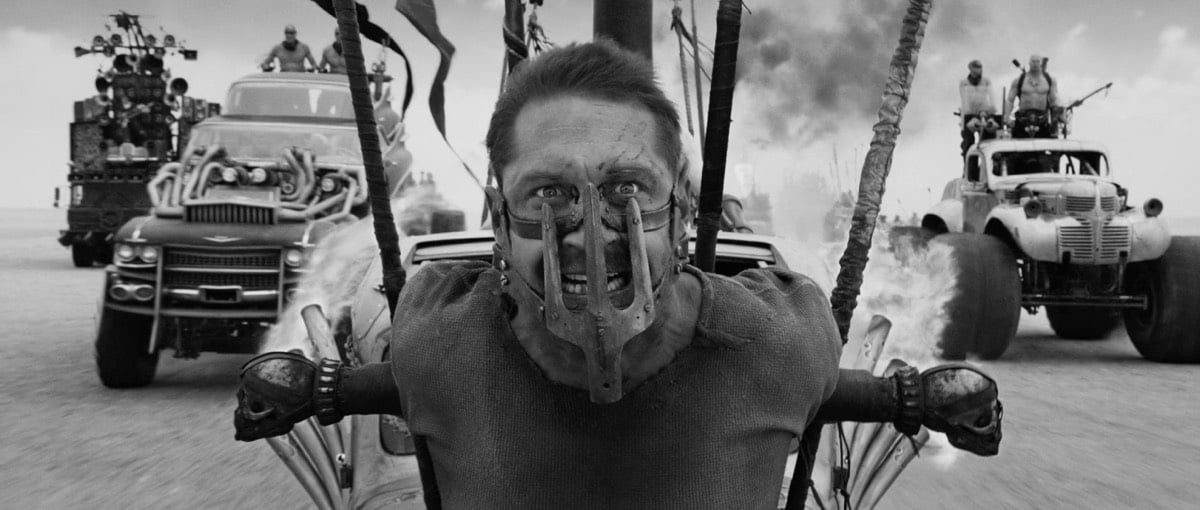
Max Max: Fury Road director George Miller has stated “the best version of this movie is black and white”. A silent B&W version of the film surfaced online briefly last year, but an official release of that best version is now here. You can find the Black & Chrome edition paired with the regular version on the film and also on the Mad Max High Octane Collection (along with all four films + bonus features). Both discs will be out in early December.
The Hamilton Cult: because of @lin_manuel’s play, the conservative hero has become a liberal darling
Living legend Vin Scully retires
Another fine example of the Great Span: Vin Scully is retiring after 67 seasons as the play-by-play announcer for the LA Dodgers. Scully started the job in 1950, when the Dodgers still hailed from Brooklyn and Connie Mack still managed the A’s:
It is amazing to contemplate that he joined the Dodgers only three years after Jackie Robinson did, and was in the booth for the first ballgame Mickey Mantle ever played in New York. It is startling to realize the on-air audition he had — and didn’t pass — to become John Madden’s TV partner was 35 years ago this month. It is mind-bending to consider that he has not just been on 22 of the 94 annual radio and television World Series broadcasts ever, but been alive for 87 of them. It is goose-bumpy to recognize that the season he began broadcasting major league games, Connie Mack was still the manager of the Philadelphia Athletics (Mack had become A’s manager in 1901 and we’ve just passed the 130th anniversary of Mack’s debut as a major league catcher).
Mack was born during the Civil War, played his first game in 1886, competed against the likes of Cap Anson and Cy Young, and had been a retired player & full-time manager for four years before an 18-year-old Ty Cobb made his major league debut. (via df)
Roger Angell is 96 and will be casting his 19th vote for President in Nov (for HRC). His first was for FDR in 1944.
Kevin Garnett retires after 21 years in the NBA. Glad that I got to see him play in person several times.
The most amazing whistler in the world
Steve Wiles is a band director from Oklahoma who is a extremely talented whistler. Wiles can whistle two melodies at the same time.
Competitive whistler Christopher Ullman is pretty good too — he doesn’t kiss before competitions and his best friend is a tube of Chapstick.
When Roger Whittaker whistles, he sounds like a damn bird! Pavarotti was also not too shabby a whistler.
Thermal photography of classic American foods

From photographer Brea Souders, an assortment of food photographed using a thermal camera.
As an object’s temperature increases, so does the amount of radiation it emits. This special camera uses state-of-the-art technology to detect infrared radiation, thereby displaying differing levels of heat in various colors and creating images reminiscent of pop art.
(thx, ray)
ASL performance of “Alexander Hamilton”
Watch Sarah Tubert perform the opening number from Hamilton in ASL. You might want to put on some headphones to hear some of the signs Tubert performs (snaps, claps, etc.)
The story of the modern cocktail revival
This looks quite good… A Proper Drink: The Untold Story of How a Band of Bartenders Saved the Civilized Drinking World.
A Proper Drink is the first-ever book to tell the full, unflinching story of the contemporary craft cocktail revival. Award-winning writer Robert Simonson interviewed more than 200 key players from around the world, and the result is a rollicking (if slightly tipsy) story of the characters — bars, bartenders, patrons, and visionaries — who in the last 25 years have changed the course of modern drink-making. The book also features a curated list of about 40 cocktails — 25 modern classics, plus an additional 15 to 20 rediscovered classics and classic contenders — to emerge from the movement.
I know bits and pieces of the story, but it’d be cool to hear the whole thing. Simonson also wrote the book on The Old-Fashioned, which would probably be my desert island cocktail. Ok, maybe a daiquiri if there were limes on the island. (via @buzz)
How the Mona Lisa became so overrated
Leonardo da Vinci’s Mona Lisa is overrated. Why? For starters, the director of the Louvre said that 80% of the museum’s visitors are there just to see the Mona Lisa. 80%! We’re talking about one of the finest museums in the world, overflowing with some of the world’s greatest artworks, and people come to only see one thing. Overrated. The story of how that happened involves a passionate art critic and a crime.
Barack Obama’s exit interview
Doris Kearns Goodwin worked in the White House for LBJ and has written extensively about US Presidents: Team of Rivals (Lincoln), The Bully Pulpit (Teddy Roosevent & Taft), and No Ordinary Time (FDR & Eleanor Roosevelt). For the November issue of Vanity Fair, she visited with Barack Obama in the White House to reflect on his progress and legacy as he approaches the end of his two terms in office. The resulting conversation is excellent.
Early in my presidency, I went to Cairo to make a speech to the Muslim world. And in the afternoon, after the speech, we took helicopters out to the pyramids. And they had emptied the pyramids for us, and we could just wander around for a couple hours [at] the pyramids and the Sphinx. And the pyramids are one of those things that live up to the hype. They’re elemental in ways that are hard to describe. And you’re going to these tombs and looking at the hieroglyphics and imagining the civilization that built these iconic images.
And I still remember it — because I hadn’t been president that long at that point — thinking to myself, There were a lot of people during the period when these pyramids were built who thought they were really important. And there was the equivalent of cable news and television and newspapers and Twitter and people anguishing over their relative popularity or position at any given time. And now it’s all just covered in dust and sand. And all that people know [today] are the pyramids.
Sometimes I carry with me that perspective, which tells me that my particular worries on any given day — how I’m doing in the polls or what somebody is saying about me … for good or for ill — isn’t particularly relevant. What is relevant is: What am I building that lasts?
I particularly enjoyed the part early on about ambition, adversity, and empathy. Oh, this short anecdote from Goodwin about LBJ is great:
L.B.J. had his amphibious car when he was president. He tricked me and took me in his car one day, and the Secret Service collaborated with him. L.B.J., behind the wheel, warned me, “Be careful, we’re going toward a lake. The brakes aren’t working.” Well, we go into the lake: the car became a boat. Then he got so mad at me because I didn’t get scared. I’d figured, He’s not going to die. And he said, “Don’t you Harvard people have enough sense to be scared?”
Has anyone in one of these interviews really pressed Obama on his drone policy? I think it’s the one big stain on his record and would love to hear his personal defense of it in length.
The 40th Anniversary Edition of the Voyager Golden Record
Just launched on Kickstarter: a gorgeous reproduction of the Golden Record that was included on the Voyager space probes when we shot them into space almost 40 years ago. The records contained images and sounds from Earth that some extraterrestrial civilization may someday view and listen to.
The Voyager Golden Record contains the story of Earth expressed in sounds, images, and science: Earth’s greatest music from myriad cultures and eras, from Bach and Beethoven to Blind Willie Johnson and Chuck Berry, Senegalese percussion to Solomon Island panpipes. Dozens of natural sounds of our planet — birds, a train, a baby’s cry — are collaged into a lovely sound poem. There are spoken greetings in 55 human languages, and one whale language, and more than one hundred images encoded in analog that depict who, and what, we are.
This is so cool. When I was doing the packages with Quarterly, one of the ideas I had on my list was to replicate the Golden Record. The production values would have been a lot more limited than this effort and the rights issue is ultimately why I never pursued it:
The overwhelming majority of the funds raised from this historic reissue will go directly to the high production costs, licensing, and royalties incurred in creating this lavish box set.
See also the Contents of the Voyager Golden Record and The sounds of Voyager’s Golden Record.
Hillary Clinton on Between Two Ferns
When you see how well it works for Donald Trump, do you ever think to yourself, “Oh, maybe I should be more racist”?
I loved this. If Galifianakis can’t get her to break, what hope does Trump have in the debates? Maybe this is part of her debate prep?
A nonfiction literary map of the United States
From Nylon, Kristin Iversen compiled her list of the best pieces of nonfiction — books, essays, memoirs — from every state in the US (plus DC and NYC). Here’s a sampling:
Alaska: Coming into the Country by John McPhee.
Connecticut: The Story of How, and Why, Martha Stewart Became the Queen of Living Well by Margaret Talbot.
Florida: The Orchid Thief by Susan Orlean. (Love this choice!)
Illinois: The Devil in the White City by Erik Larson. Strong runner-up here is the amazing The Warmth of Other Suns (which I reviewed here).
Vermont: Where the Roads Have No Name by Geoff Manaugh.
Uncanny car impressions
Daniel Jovanov does fantastic impressions of cars. In the video above, he imitates them so well that a trio of actual race car drivers are able to pick out exactly which ones he’s doing. I think he’s gotten better since his appearance on Australia’s Got Talent several years ago:
“The most powerful artwork I have ever seen”

New York Magazine art critic Jerry Saltz has presumably been to most of the finest museums in the world, seen the works of the great masters, and generally spent a lifetime looking at great art. But he encountered what he calls “the most powerful artwork I have ever seen” in a French cave with drawings from about 13,000 years ago.
The idea that perspective was invented in Florence in 1414 collapsed in an instant. Here, larger mammals are in front of smaller ones who trail behind; animals at the back of packs are smaller than those in front. There’s also what’s called reverse perspective, the sort of system used in China, where closer things are rendered smaller than farther things. Elsewhere, an ibex is depicted from behind and over the shoulder — an incredibly sophisticated perspective. One horse is seen from a highly accomplished three-quarters view. Imagery seemed adjusted for curvatures and protrusions of the walls in the same ways that Renaissance frescoes adjust for distortions, distance, and odd viewing angles. I saw a bison with one horn curving up, the other curving down — either from battle or birth. Whatever the cause, this was something that had been seen and intentionally rendered.
Just penciled this in for my next trip to France, whenever that is.
Nazi rallies in Madison Square Garden in the 1930s

In the 1930s, almost a decade before the nation’s young men would be shipped overseas to combat the foul stench of Hitler wafting across Europe, official and unofficial rallies for the Nazi party were held in Madison Square Garden.
Shortly after Adolf Hitler’s appointment as Chancellor of Germany in January 1933, the Nazis consolidated control over the country. Looking to cultivate power beyond the borders of Germany, Deputy Führer Rudolf Hess charged German-American immigrant Heinz Spanknobel with forming a strong Nazi organization in the United States.
Combining two small extant groups, Spanknobel formed Friends of New Germany in July 1933. Counting both German nationals and Americans of German descent among its membership, the Friends loudly advocated for the Nazi cause, storming the offices of New York’s largest German-language paper, countering Jewish boycotts of German businesses and holding swastika-strewn rallies in black-and-white uniforms.
A later group, which only disbanded at the end of 1941, were prominently pro-American and featured iconography of George Washington as “the first Fascist”. (I would have gone for “the Founding Fascist”…catchier.)
Should we use CRISPR to engineer mosquitoes incapable of transmitting malaria?
Thousands of people die every day from malaria, a disease that is transmitted to humans solely through mosquitoes. With CRISPR, scientists can easily genetically engineer mosquitoes incapable of transmitting malaria and using a technique called gene drive, they can force that genetic change into the native mosquito population. So, should we do it?
Monty Python’s Argument Sketch performed by two vintage speech synthesizers
In a sketch from Monty Python called Argument Clinic, a character played by Michael Palin goes to a facility and pays to have an argument with John Cleese. That argument was recreated for this video using a pair of old school speech synthesizers. Palin’s part is played by the DECTalk Express (aka the voice of Stephen Hawking) and Cleese’s part is played by the Intex Talker. As you can probably hear, the Talker predates the DECTalk by a few years and is more difficult to understand. (via @303)
Passengers
You had me at Chris Pratt and J. Law in space. I hope this doesn’t suck.
Jennifer Lawrence and Chris Pratt are two passengers onboard a spaceship transporting them to a new life on another planet. The trip takes a deadly turn when their hibernation pods mysteriously wake them 90 years before they reach their destination.
On the shifting role of racism in American slavery
In a recent episode of his EconTalk podcast, host Russ Roberts talks with Michael Munger about a paper Munger co-authored about how white Southern attitudes toward slavery shifted from around 1815 to 1835. The episode is interesting throughout,1 but I want to highlight this attitude shift Munger writes about in the paper, something I was previously unaware of.
Sifting through documents from the era between the American Revolution and the Civil War, Munger and his co-author Jeffrey Grynaviski found that Southern whites believed, in the first decade or two of the 19th century, that owning slaves was evil but necessary. There was this system in place and it was bad but we’re gonna go with it because, whaddya gonna do? But in a period of about 20 years, due to a variety of factors, mostly economic, the justification for slavery shifted primarily to a racist one: that black people were inferior and needed to be cared for by whites. Southern whites came to believe, like really believe, that they were doing their slaves a favor by enslaving them and that the slaves were better off than they would be in Africa.
The way we defined it in this paper was that racism became a substitute justification for slavery. And the reason was, the original justification for slavery, which was the Roman one of wasn’t good enough. And so Southerners cast about and found basically an alternative, which was the Greek justification for slavery. And let me just say very briefly what those two are. The one justification for slavery, and it was pretty common in Rome, was that if you lost a battle and were captured, then you might either be killed or kept as a slave. And there is a mutually beneficial exchange, if you will, in the sense that you’ve already lost. So, me saying, ‘I tell you what: I won’t kill you if you will agree to act as my slave for the rest of your life. And I may free you; I may not; but that’s up to me.’ And you say, ‘Killed/be a slave: I’m going to go with the slave thing.’ But, it meant that some slaves were very excellent. And in Roman society some slaves occupied very high positions, positions of respect. It’s just that they made this promise. It was an economic institution. And that was the way that slavery had existed in Africa: if you lost a battle, then you would be captured by the other side. It was almost like indentured servitude: you could work it off.
Well, that didn’t work in the American South because they wanted to maintain slaves, to be able to identify slaves and to have a justification that would allow them to enslave the children — which the old Roman justification would never have allowed. You are not going to be a slave if you are born to a slave, because you didn’t lose in battle: you would have been free.
So, the Southerners needed a different way, so they were looking for the Aristotelian notion of slavery, which is that slaves are people who are either morally inferior or lack the judgment to make independent choices. They are like children or like horses. That means that you actually have a positive-good justification for enslaving them: if I have a thoroughbred horse or a fancy dog, it would be cruel of me to set it loose to let it run around, because it’s not capable of taking care of itself. I have obligations to take care of it. My ownership actually gives me obligations. And what’s interesting and what this paper is about is how Southerners worked that out between about 1815 and 1835, and started to understand the implications for how they had to change the economic institutions of slavery to match this new ideology that they were creating.
Yet another example of how powerful economic self-interest is in shifting moral beliefs.
Although it was uncomfortable at times listening to two privileged pro-market white guys talking about slavery, particularly in the moments where they discuss matters from the slaves’ perspectives. But in fairness, they do a good job in admitting their privilege and the awareness that their economic beliefs may not square with things like human rights and justice forms the basis of a fascinating conversation.↩
The Monty Hall Problem, explained
The Monty Hall Problem is one of those things that demonstrates just how powerful a pull common sense has on the human reasoning process. The problem itself is easily stated: there are three doors and behind one of them there is a prize and behind the other two, nothing. You choose a door in hopes of finding the prize and then one of the other two doors is opened to reveal nothing. You are offered the opportunity to switch your guess to the other door. Do you take it?
Common sense tells you that switching wouldn’t make any difference. There are two remaining doors, the prize is randomly behind one of them, why would switching yield any benefit? But as the video explains and this simulation shows, counterintuition prevails: you should switch every time.
America was introduced to the difficulty of the problem by Marilyn vos Savant in her column for Parade magazine in 1990.1 In a follow-up explanation of the question, vos Savant offered a quite simple “proof” of the always switch method (from Wikipedia). Let’s assume you pick door #1, here are the possible outcomes:
| Door 1 | Door 2 | Door 3 | Result if you stay | Result if you switch |
|---|---|---|---|---|
| Car | Goat | Goat | Wins car | Wins goat |
| Goat | Car | Goat | Wins goat | Wins car |
| Goat | Goat | Car | Wins goat | Wins car |
As you can see, staying yields success 33% of the time while if you switch, you win 2 times out of three (67%), a result verified by a properly written simulator. In his Straight Dope column, Cecil Adams explained it like so (after he had gotten it wrong in the first place):
A friend of mine did suggest another way of thinking about the problem that may help clarify things. Suppose we have the three doors again, one concealing the prize. You pick door #1. Now you’re offered this choice: open door #1, or open door #2 and door #3. In the latter case you keep the prize if it’s behind either door. You’d rather have a two-in-three shot at the prize than one-in-three, wouldn’t you? If you think about it, the original problem offers you basically the same choice. Monty is saying in effect: you can keep your one door or you can have the other two doors, one of which (a non-prize door) I’ll open for you.
See also the case of the plane and the conveyor belt (sorry not sorry, I couldn’t resist).
I was a religious reader of Parade and remember this column and the resulting furor very clearly. Re: the furor, it’s so interesting to note in hindsight (being 16 and clueless at the time) how much of the response was men who clearly were trying to put the smackdown on a prominent, intelligent woman and they just got totally owned.↩
Storm Photography by Mitch Dobrowner



Mitch Dobrowner takes wonderfully dramatic black & white photos of clouds and storms from across the plains of the central United States. Dobrowner, who lives in California, became “addicted” to photography as a teen after discovering Ansel Adams and Minor White but then gave it up to spend energy on his career and family. A few years ago, he picked his old obsession back up and these storm photos are the result. (via colossal)
Oh shit, git! What to do when you screw something up in Git.
How to make McDonald’s McRib at home

That, my friends, is a photo of Kenji López-Alt’s homemade McRib sandwich. The McDonald’s version is beloved but has been on and off the menu with maddening irregularity, so Kenji spent weeks/months creating a McRib recipe for the home cook.
The problem is that, while the McRib might be inspired by real barbecue, it’s ultimately a lie. Despite its corrugated appearance, it has little to do with actual ribs. (McDonald’s doesn’t even indicate that the product contains actual rib meat.) It’s not smoked, as one would expect of barbecue ribs. Indeed, it’s not even grilled — it’s cooked on a griddle. We can do better.
My goal? Take everything we love about the McRib sandwich and turn it up to 11, by starting from scratch with a few high-quality ingredients and a lot of good technique (including honest-to-goodness smoking). I wanted to maximize flavor and texture, unlocking the sandwich’s full potential and allowing it to evolve, Pokémon-style, into something so much better.
One of my favorite pieces of food writing from the past few years is Willy Staley’s piece on the economics of the McRib.
And for recipes for more of your favorite fast food at home, see the homemade Shack Burger, homemade McDonald’s fries, homemade Egg McMuffin, homemade Big Mac, and homemade Chick-Fil-A.
MoMA puts 1000s of historical exhibition photos online





The Museum of Modern Art has started the process of putting online a massive trove of photographs of what the museum’s exhibitions looked like, extending back to their earliest big exhibition in 1929 of works by Cézanne, Gauguin, Seurat, and van Gogh. The NY Times has the story.
The digital archive project will include almost 33,000 exhibition installation photographs, most never previously available online, along with the pages of 800 out-of-print catalogs and more than 1,000 exhibition checklists, documents related to more than 3,500 exhibitions from 1929 through 1989.
Shown above are some notable works of art pictured among the first times they were displayed at the museum…the top one is from that first show in 1929. I happily spent an hour browsing through these exhibitions1 and I haven’t been gripped with this powerful of a desire to travel through time in quite some time. To be able to see that first exhibition…what a thing that would be. In part, I love going to museums for this very reason: standing in the very spot where the artist stood in making their drawing or painting is a very cheap form of time travel.
Suggested technique: search for an artist or artwork you particularly like and sort the results by “opening date, chronological” to see the first time that art or artist was displayed in the museum.↩
Tracking Homer Simpson’s jobs and salary
Vox recently took a look at every single job that Homer has ever had on The Simpsons in an attempt to see where his average salary falls on the economic spectrum in America.
Over the show’s 596-episode run, Homer has had at least 191 jobs. They’ve ranged from executive positions to service jobs, and have dotted the entire economic spectrum, from ultra-rich to the poverty line.
In the list below, we’ve compiled the real-life salaries for 100 of these jobs. Seasonal jobs (like “mall Santa”), and jobs that were virtually impossible to find salary data for (“beer smuggler”) were excluded, as were any repeats (he was an Army private twice, for instance). His full-time gig as a safety inspector is highlighted in yellow, for reference.
He gets a lot of flack, but Homer is actually the most interesting person in America by a wide margin, even though he’s not well compensated for it.
The genius of Spielberg’s Saving Private Ryan battle scene
For a recent episode of Nerdwriter, Evan Puschak takes a look at how Steven Spielberg constructed the intense opening scene of Saving Private Ryan. His decision to film the Omaha Beach landing from the perspective of a battlefield cameraman — something he cribbed from actual WWII battle footage and John Ford’s The Battle of Midway, where scenes in which on-set explosions made the film skip were kept in the finished movie — made it one of the best depictions of war ever created. I need to watch this movie again soon.
An incredible detail Puschak notes: the shot-length in that scene was surprisingly long, particularly for a battle scene. In fact, the shot length in that scene was more than double that of the entirety of 300, any Transformers movie, and Inception.
The Daily Spoon

In 2014, Stian Korntved Ruud hand-carved a different wooden spoon every single day for the entire year. Yep, 365 spoons.
The past year Stian spent most of his time exploring the unique organic qualities of wood and how adding of a function can beautifully refine a piece of wood. The project consists of 365 unique hand carved spoons made from various types of wood. One carved everyday through a year.
By repeating the production of a spoon every day for a longer period of time (365 days), the goal is to challenge and explore a spoons aesthetic and functional qualities.
(via @pieratt)
Impressive insect camouflage
Meet the lichen katydid. Hailing from the forests of Central and South America, this insect has evolved over the millennia to blend in amazingly well with the lichens that populate the forest. Video by David Weiller.
100 objects that shaped public health
From the School of Public Health at Johns Hopkins comes this list of 100 things that have “made their mark on public health”, good and bad. Here’s a sampling of the objects:
Horseshoe crab. We all owe a debt of gratitude to the helmet-shaped horseshoe crab, whose ancestors date back 450 million years. From vaccines to needles to pacemakers, any IV drug or medical equipment that will come in contact with the human body must first be safety-checked using a test that comes from a clotting compound in the crab’s blood. This compound can detect even the smallest amount of deadly bacteria and is sensitive enough to isolate a threat equivalent to the size of a grain of sand in a swimming pool.
Vaccines. Immunization is one of the most important public health achievements in human history. Vaccines helped eradicate smallpox globally and eliminate polio in the United States. The introduction of effective vaccines has also drastically reduced deaths from measles, diphtheria, rubella, pertussis (“whooping cough”) and other diseases that sickened hundreds of thousands of Americans in the early 20th century.
American Cheese. Food processing was actually developed to make food safer. Milk is pasteurized to kill harmful organisms, and canning and freezing foods such as meats, fruits and vegetables helps them last longer. But the food industry has taken processing well beyond these early origins. Often, to extend a food’s shelf life, manufacturers increase fats, sugars, and salt and add in chemical flavorings, emulsifiers, and other additives — taking foods that could have been healthy and making them much less so.
Pap smear. Since its introduction in 1955, the Pap smear has reduced death from cervical cancer by more than 60 percent. Invented by Dr. Georgios Papanikolaou, the Pap smear is a diagnostic procedure in which a health-care professional swabs a cell sample from the cervix and sends it to a lab to see if any of the cells are malignant. Before the invention of the Pap smear, cervical cancer was one of the leading causes of death for women of childbearing age in the United States. Today, it comes in at number 14 on the list of cancers found in women.
Spittoons. Spittoons were developed centuries ago as receptacles for spitting — think ashtrays for saliva. These brass or even porcelain repositories were everywhere: In homes, train stations, saloons and even the U.S. Congress. They were meant for men to dispose their chewing tobacco and the abundant phlegm that accompanied the habit. Convenience turned to concern in the late 19th century when a global tuberculosis epidemic took hold and scientists realized that spittoons might actually spread diseases. Some argued that when people spat in the general direction of a spittoon and missed the target, they caused a greater health threat than if the spittoon hadn’t been there at all.
The internet of trees: how trees talk to each other underground
In June, ecologist Suzanne Simard gave a talk at TED about her 30 years of research into how trees talk to each other. Underneath the forest floor, there is a communications network on which trees — even those from different species — trade carbon with each other, send warnings, and trade messages. Simard described one of her first experiments (from the transcript):
I pulled on my white paper suit, I put on my respirator, and then I put the plastic bags over my trees. I got my giant syringes, and I injected the bags with my tracer isotope carbon dioxide gases, first the birch. I injected carbon-14, the radioactive gas, into the bag of birch. And then for fir, I injected the stable isotope carbon-13 carbon dioxide gas. I used two isotopes, because I was wondering whether there was two-way communication going on between these species.
The idea was to use the isotopes to track whether the trees were trading carbon when some of them were shaded and less able to make their own energy.
The evidence was clear. The C-13 and C-14 was showing me that paper birch and Douglas fir were in a lively two-way conversation. It turns out at that time of the year, in the summer, that birch was sending more carbon to fir than fir was sending back to birch, especially when the fir was shaded. And then in later experiments, we found the opposite, that fir was sending more carbon to birch than birch was sending to fir, and this was because the fir was still growing while the birch was leafless. So it turns out the two species were interdependent, like yin and yang.
Fascinating. German forester Peter Wohlleben came out with a book this week called The Hidden Life of Trees: What They Feel, How They Communicate (Simard contributed a note to the book). From a Guardian review:
Trees have friends, feel loneliness, scream with pain and communicate underground via the “woodwide web”. Some act as parents and good neighbours. Others do more than just throw shade — they’re brutal bullies to rival species. The young ones take risks with their drinking and leaf-dropping then remember the hard lessons from their mistakes. It’s a hard-knock life.
The Monthly, Maclean’s, and Scribd all have excerpts of Wohlleben’s book if you’re interested.
Update: See also this episode of Radiolab, From Tree to Shining Tree. (via @Chan_ing)
The economics of running a NYC restaurant. This is bleak…NYC restos are a bubble propped up by dumb money.
The Murder of Stephen King
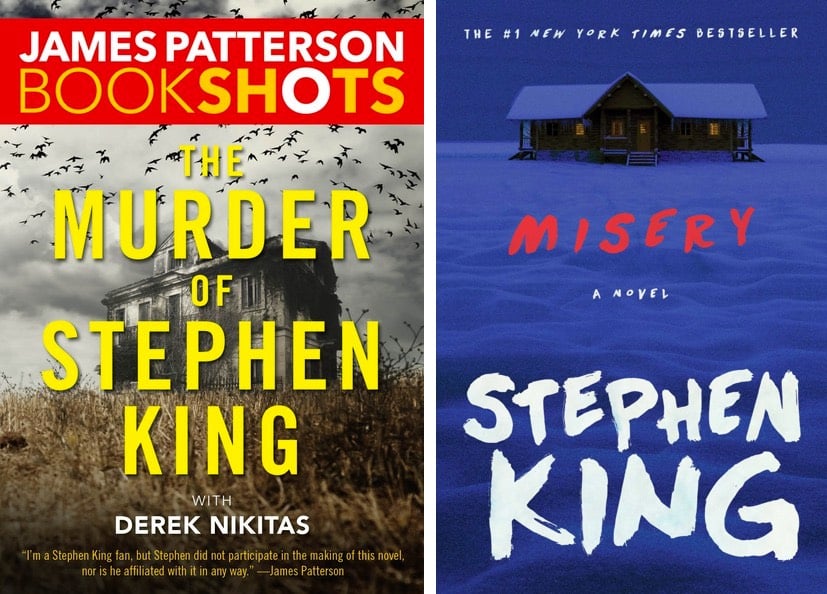
This is weird. Super-prolific author James Patterson, who has written hundreds of books and earns millions of dollars a year from royalties, has co-authored a book called The Murder of Stephen King. King is, of course, a merely prolific author who also publishes popular novels with massive appeal, including one about a writer being victimized by his biggest fan.
Stephen King is being hunted by a killer obsessed with his novels. How far will their reenactments go?
All of Stephen King’s greatest villains, rolled into one.
Stephen King is facing a nightmare. A stalker is reenacting the horrors from his novels. And he won’t stop until he kills the master of suspense himself — unless King puts him out of his Misery first.
Misery! Get it? Patterson is quoted on the front cover of the book:
I am a Stephen King fan, but Stephen did not participate in the making of this novel, nor is he affiliated with it in any way.
According to this AP story, King and Patterson do not know each other and King is not complimentary about his fellow writer’s skills.
While Patterson speaks warmly of King, King has not returned the compliments in the past. In a 2009 interview with USA Weekend, he said Patterson was “a terrible writer but he’s very successful.” Speaking to the AP, Patterson is dismissive of King’s remarks, calling them “hyperbole,” in the style of Donald Trump.
“I know I’m not a terrible writer,” Patterson says. “That’s a little over the top.”
Update: Upon reflection, Patterson has decided not to release the book.
In a statement released Thursday through Little, Brown and Company, Patterson said he didn’t want to cause King or his family “any discomfort.” The book was intended as a tribute to King, a King-like story of an obsessed fan out to get the writer. But Patterson, who co-authored the 150-page novel with Derek Nikitas, said he had learned that fans in real life had “disrupted” King’s home.
“My book is a positive portrayal of a fictional character, and, spoiler alert, the main character is not actually murdered,” he said. “Nevertheless, I do not want to cause Stephen King or his family any discomfort. Out of respect for them, I have decided not to publish ‘The Murder of Stephen King.’”
RIP, The Murder of Stephen King. (via @koaostrem)
Pardon Edward Snowden
The ACLU, Amnesty International, and Human Rights Watch are calling for the pardon of Edward Snowden. The ACLU:
The government has charged Snowden under the Espionage Act, a World War One-era law that doesn’t distinguish between selling secrets to foreign governments and giving them to journalists working in the public interest. If Snowden were to be tried under the charges he faces, any argument that his actions benefited the public would be inadmissible in court.
The Pardon Snowden campaign will work through the end of Obama’s administration to make the case that Snowden’s act of whistleblowing benefited the United States and enriched democratic debate worldwide, and we’re asking citizens to write to the president via our website.
Though some government officials claimed that irreversible harm had been done to US national security, little evidence has been aired publicly. Snowden entrusted the release of information to seasoned journalists and made them promise to inform the government and consider any claim of harm to national security in advance of publication. Adm. Michael Rogers, on taking the helm of the NSA a year into the revelations, told the New York Times he couldn’t say “the sky is falling.” Even Attorney General Eric Holder, who still advocated Snowden’s prosecution as he left office, conceded he performed “a public service.”
“Edward Snowden clearly acted in the public interest. He sparked one of the most important debates about government surveillance in decades, and brought about a global movement in defence of privacy in the digital age. Punishing him for this sends out the dangerous message that those who witness human rights violations behind closed doors should not speak out,” said Salil Shetty, Amnesty International’s Secretary General.
“It is ironic that it is Snowden who is being treated like a spy when his act of courage drew attention to the fact that the US and UK governments were illegally spying on millions of people without their consent.
“The mass surveillance exposed by Snowden impacts the human rights of people around the world. Our new campaign gives the public a chance to call for his pardon and thank him for triggering action by concerned individuals around the world to take back their privacy.”
Several prominent individuals have lent their support to the effort as well, including Steve Wozniak, Eve Ensler, Daniel Ellsberg, and Teju Cole. Bernie Sanders is also urging some form of clemency fror Snowden.
Why this push now? Obama is leaving office (typically a good time for pardons) and Oliver Stone’s Snowden is due out in theaters tomorrow. The reviews aren’t bad and Joseph Gordon-Levitt’s impersonation of Snowden is uncanny (see the trailer).
A vending machine for releasing anger

Artists Katja Kublitz and Ronnie Yarisal built Anger Release Machine, a vending machine stocked with breakable items like glass plates, porcelain statues, etc. When you put some coins in, the machine dispenses an item, sending it crashing against the bottom of the machine. Then, you feel better. I love the concept, but the implementation leaves something to be desired. Here’s a video of the machine in “action”:
(via bb)
Medieval Europe by Chris Wickham

Ooh, this looks good: Medieval Europe is Oxford historian Chris Wickham’s “spirited and thought-provoking history of the vast changes that transformed Europe during the 1,000-year span of the Middle Ages”.
Tracking the entire sweep of the Middle Ages across Europe, Wickham focuses on important changes century by century, including such pivotal crises and moments as the fall of the western Roman Empire, Charlemagne’s reforms, the feudal revolution, the challenge of heresy, the destruction of the Byzantine Empire, the rebuilding of late medieval states, and the appalling devastation of the Black Death. He provides illuminating vignettes that underscore how shifting social, economic, and political circumstances affected individual lives and international events.
Here’s a short excerpt on the Yale University Press blog.
The Middle Ages get short shrift in tellings of European history (as evidenced by the term “Dark Ages”…and even “Middle” implies something moving between two better eras), but recently historians have been working on filling out the story and rehabilitating that period. I really enjoyed Wickham’s The Inheritance of Rome, so I’m looking forward to digging into this when it comes out in November.
The Auction Chant
Did you ever wonder what the auctioneer is saying when they’re trying to get people to bid on things? They talk so quickly it’s hard to tell sometimes, so Barry Baker of Ohio Real Estate Auctions slows down the action to describe exactly what auctioneers are saying.
See also one of my favorite silly things from recent months: Auctioneer beats.
2016 fall foliage map

As I remarked last year, the Smoky Mountains website has the best fall foliage map in the business. The map covers the entire US and comes with a slider that lets you check the status weekend by weekend throughout the fall. Looks like the foliage will peak near Sept 30th in VT and Oct 14th in NYC and in the Smoky Mountains.
The Illustrated Book of Poultry
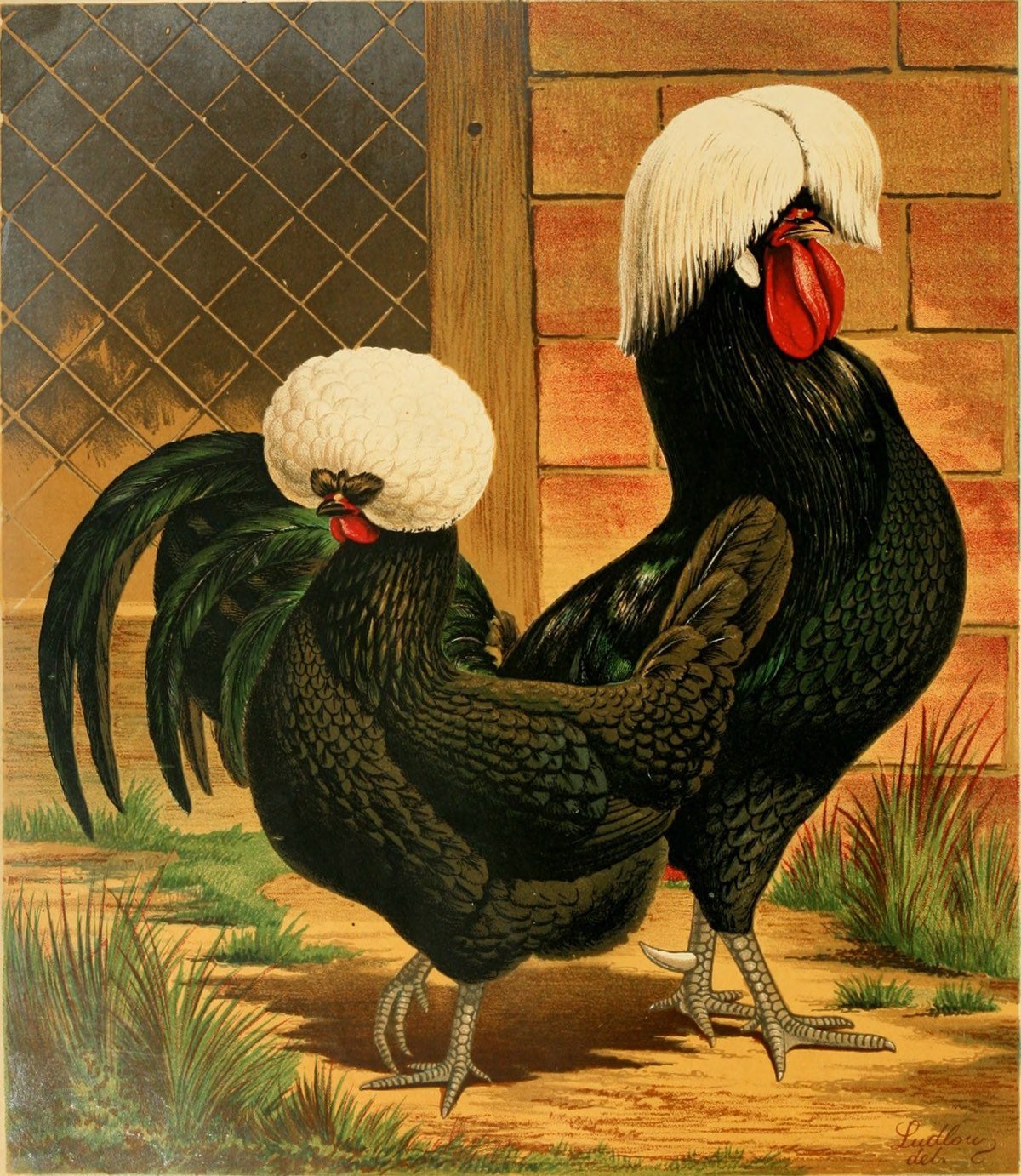
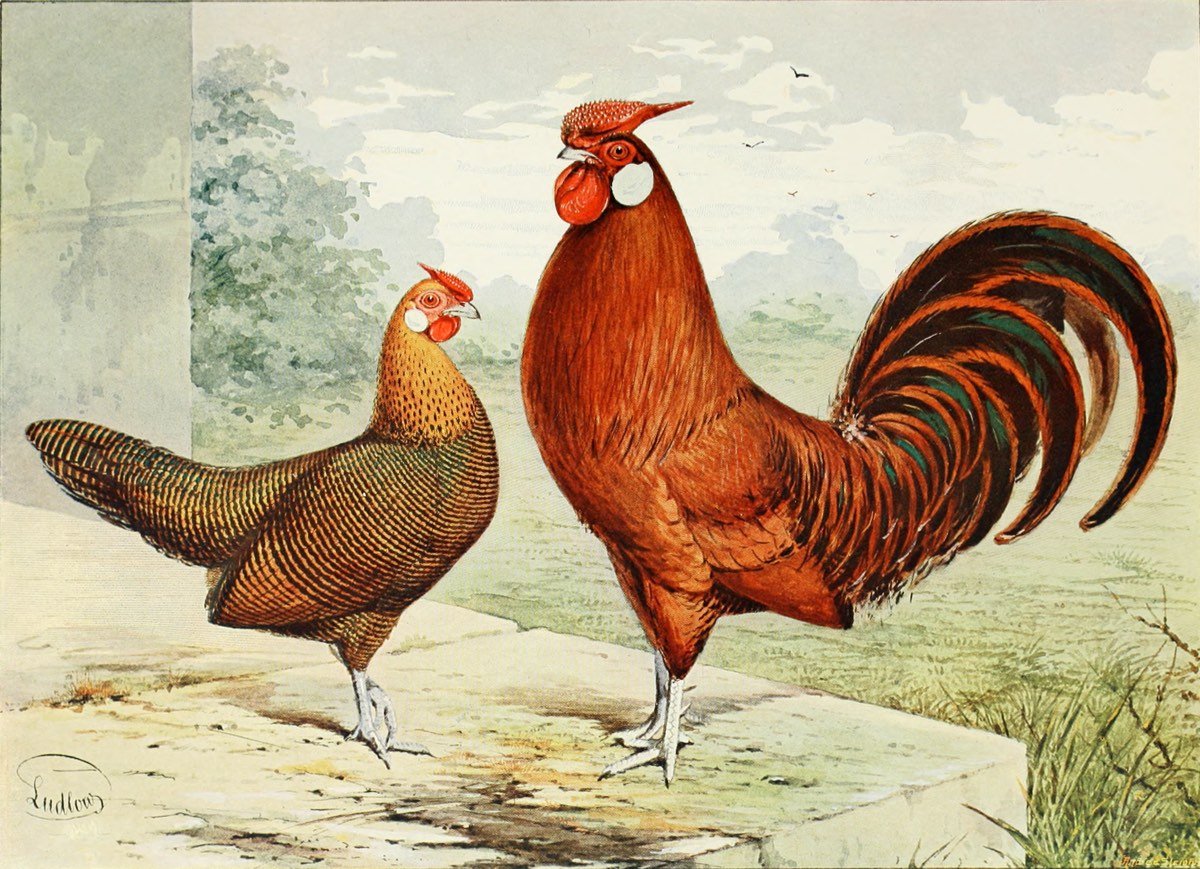
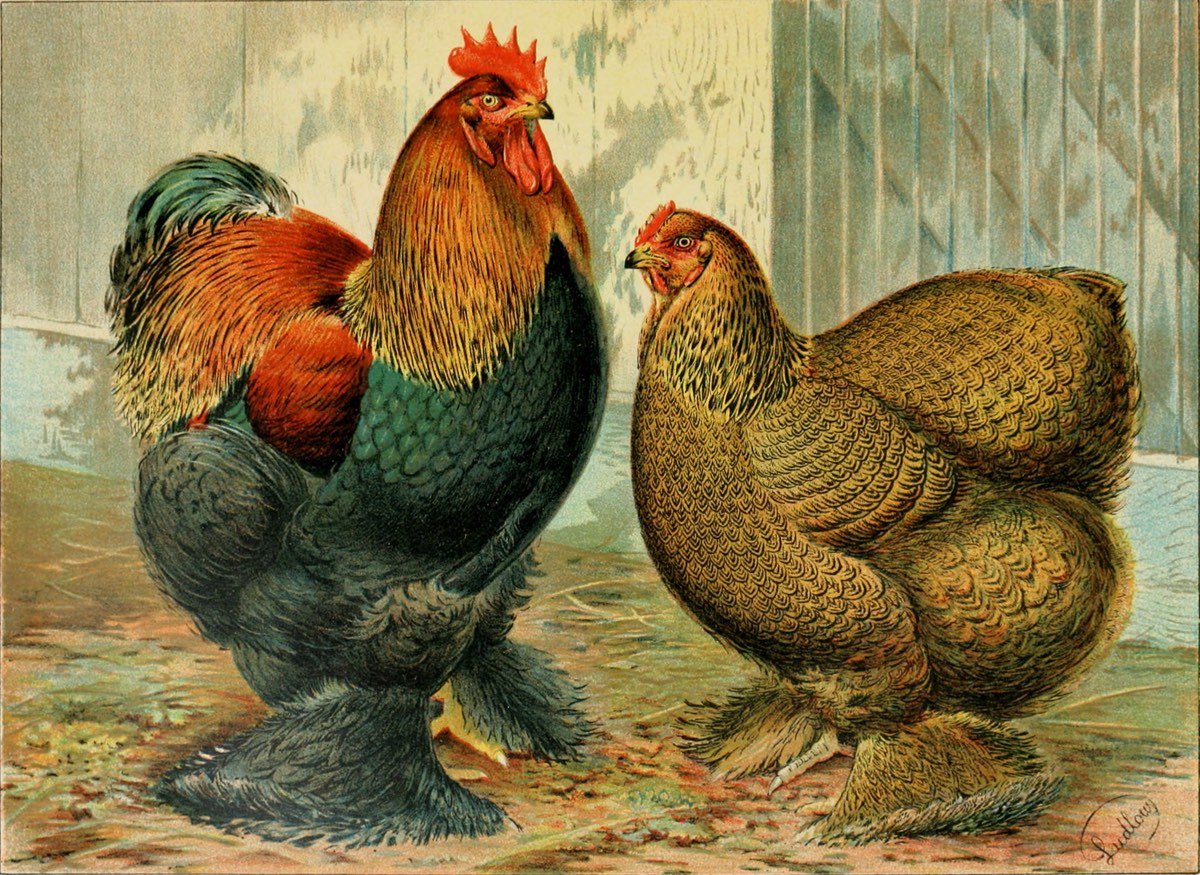

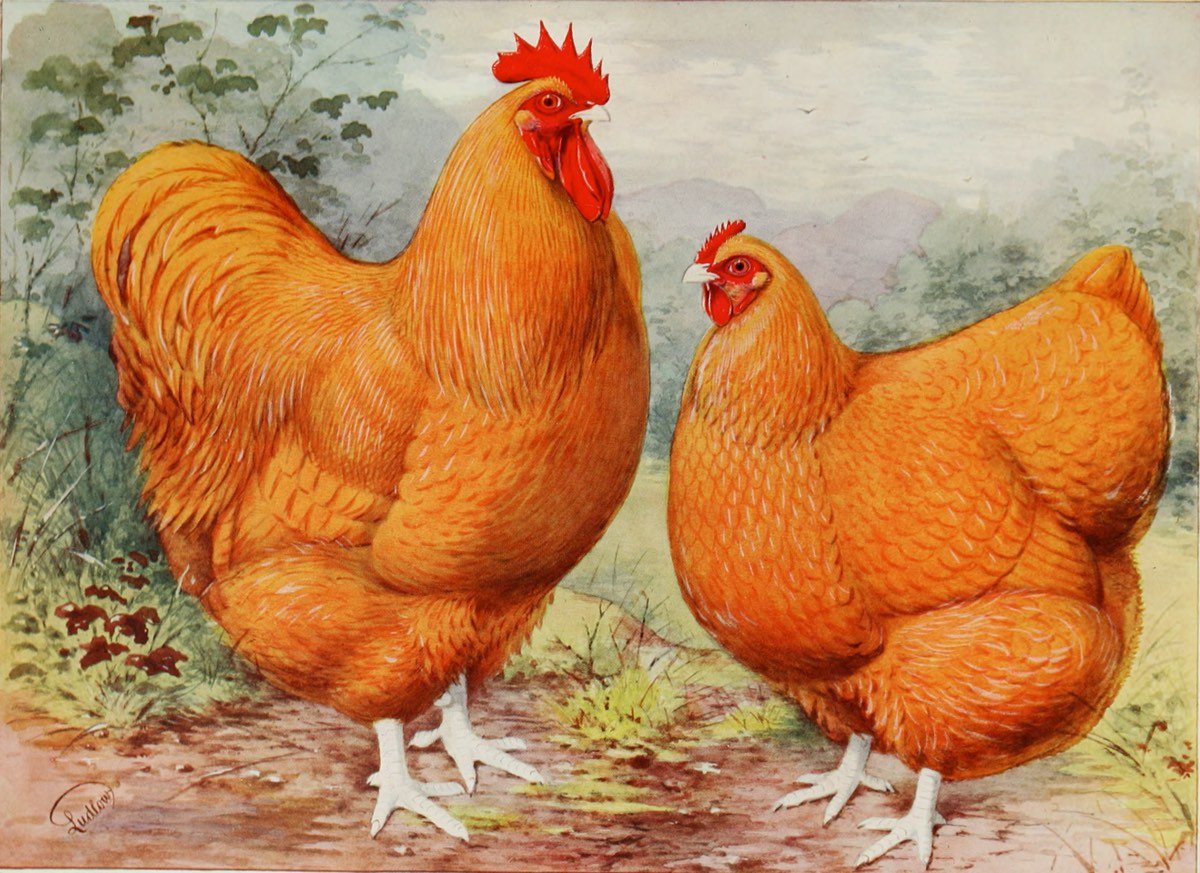
The Illustrated Book of Poultry by Lewis Wright, first published in 1870 and revised several times in the decades following, was “regarded as the most desirable of the English poultry books”. Poultry was very popular in Victorian England and the book housed a tremendous amount of practical poultry knowledge. From a Harvard Library blog post:
“Hen Fever”, as it became known during the Victorian Age, was an unprecedented obsession with owning, breeding, and showing the finest chickens in the world. The genesis of the poultry fancier owes much to Queen Victoria and her royal menagerie. In 1842, she acquired exotic chickens from China, and whatever the Queen did, the public would soon try to imitate and incorporate at home. The Illustrated London News reported “Her Majesty’s collection of fowls is very considerable, occupying half-a-dozen very extensive yards, several small fields, and numerous feeding-houses, laying-sheds, hospitals, winter courts, &c.”. From this point forward, poultry was no longer viewed as common farmyard critters, but valued and appreciated throughout the classes of Victorian Britain. The import and breeding of poultry was not just a leisurely hobby, but a profitable endeavor with sky rocketing price tags for the finest examples.
But the books also contained many wonderful illustrations of the finest examples of chickens and other poultry in the style of Audubon. The different breeds have amazing names like Buff Orpingtons, Plymouth Rocks, Dark Dorkingtons, and Gold Pencilled Hamburghs.
I pulled the images above from a 1911 edition of the book. (via @john_overholt)
Update: I removed a link to a reproduction of the book on Amazon because a reader reported that the quality was not great. (thx, alex)
The quiet empathy of Mr. Rogers lives on
Speaking of Mr. Rogers, Arielle Bernstein wrote about how the spirit of Mister Rogers’ Neighborhood lives on in contemporary advice columns like Ask Polly (now a book!), Dear Sugar, and Ask Andrew W.K.
Rogers offered something different from other TV icons — he used his show as a platform to actually give voice to children: their fears, their hopes, their pains, their purest expressions of joy. Each episode of Mister Rogers’ Neighborhood started with the same reassuring sequence showing the host entering his home, slipping on one of his famous sweaters, and changing his work shoes for comfortable sneakers. In this simple world, every question — big or small — was seen as worthy of respect; every feeling — good or bad — was viewed without judgment. Rogers answered questions in an open-hearted manner, often drawing on his own experiences and speaking directly into the camera, as if personally addressing each member of his TV audience. In one episode, he drew a picture using crayons and reflected, “I’m not very good at it. But it doesn’t matter … It feels good to have made something.” In another, the camera lingered on one of Rogers’ dead fish with the curiosity and compassion of a child, imploring viewers to look, telling them that it’s okay to cry.
Today’s advice columnists carry on this same tradition of giving their readers the space to explore emotions they might feel they have to downplay, ignore, or hide from others. At a time when millions of adults are snapping up coloring books, and essays bemoan college students for seeking “safe spaces,” it might be tempting to see the gentler column as an outgrowth of a desire to prolong childhood. But the success of these columns points instead to the very grown-up need for settings where feelings are valued, rather than dismissed, and where the primary human response is compassion, rather than anger.
Ikea is upping their design efforts (but not prices). Also: “1 in 10 Europeans is conceived in an Ikea bed”.
The Gluten Free Museum
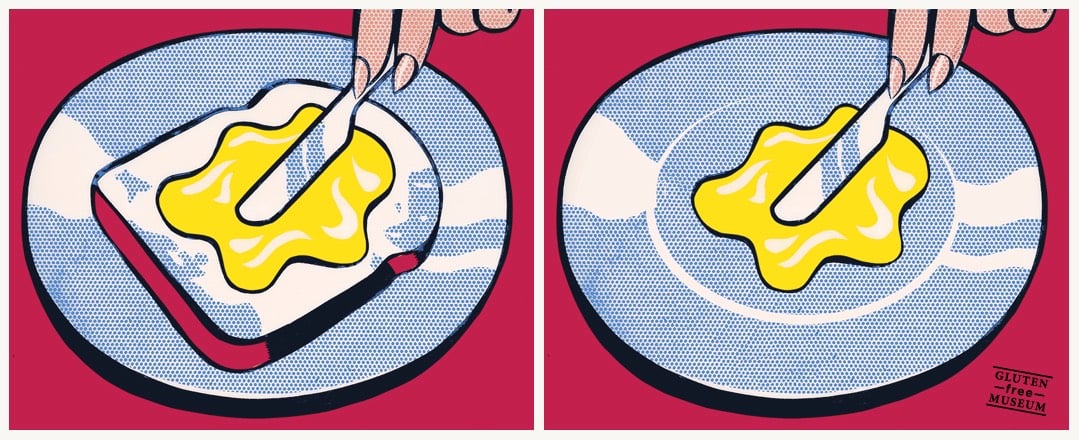
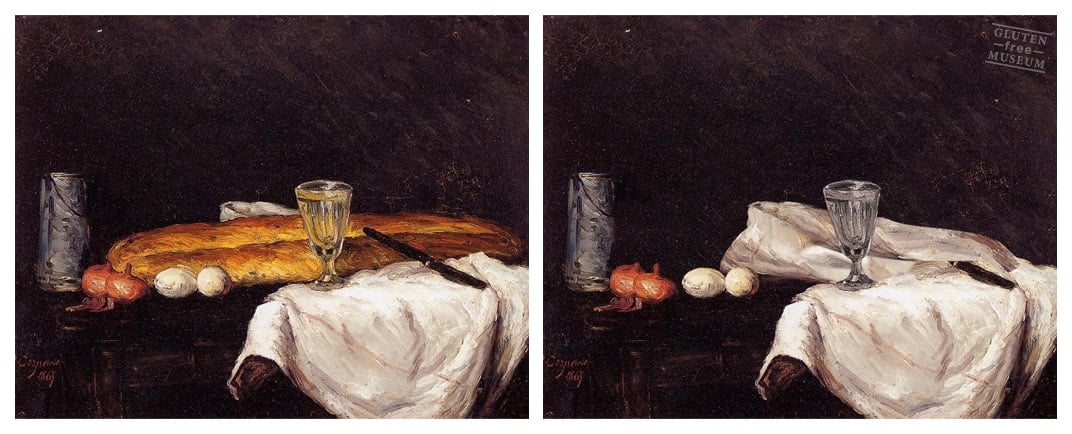

Gluten Free Museum takes works of art (high and low) and removes all of the gluten from them. A one-trick pony, but a particularly entertaining one. (via tmn)
How the Sugar Industry Shifted Blame to Fat. This stuff makes me ANGRY. Fucking shady scientists.
A timeline of the Earth’s average temperature

From XKCD, a typically fine illustration of climate change since the last ice age ~20,000 years ago.
When people say “the climate has changed before”, these are the kinds of changes they’re talking about.
And then in the alt text on the image:
[After setting your car on fire] Listen, your car’s temperature has changed before.
The chart is a perfect use of scale to illustrate a point about what the data actually shows. Tufte would be proud.
Update: Tufte is proud. (via @pixelcult)
Why does blockbuster movie music all sound boring and the same?
The series of Marvel movies — X-Men, Avengers, Spider-Man, etc. — is the highest grossing film series of all time but the films’ music is largely forgettable and bland in a way that it isn’t in Star Wars, James Bond, or Harry Potter. In this video, the Every Frame a Painting gang explores why that is: partially a trend toward movie music not designed to be noticed and also the use by directors of temporary music that unduly influences the final score. All the Marvel movies run together for me (aside from Guardians of the Galaxy, which had distinctive music in it, I can’t recall a single scene from any one of the more recent films) and perhaps the music is one reason.
There’s a follow-up video to the one above composed of clips of movies played with their temp music followed by the same clips with the final music, which is nearly identical.
They’ve also started a Twitter account highlighting the influence of temp music on final scores.
These videos have me wondering…was Carter Burwell’s score for Carol influenced by temp music, specifically Philip Glass’ score for The Hours? This interview in Rolling Stone and the FAQ on his site suggest not:
It’s his ability to make music that compliments a scene rather than eclipse it that has made him an invaluable creative partner to filmmakers who work in such intense melodramatic registers, and Burwell is emphatic that his scores aren’t responsible for all of the emotional heavy-lifting. “As a listener, I do not like being instructed,” he says, emphatically. “It riles me when the music tells me something before I can figure it out for myself. In fact, I enjoy the discomfort of not being sure how to take something.” It’s the reason why he loathes listening to the temp music that directors often attach to rough cuts in order to point composers in the right direction.
But the similarities are there, so who knows?
Update: I forgot to mention that Stanley Kubrick ended up ditching the original score written for 2001 and sticking with the temp music, which were the classical compositions by Strauss et al. that we’re so familiar with today.
Update: In a video response, Dan Golding shows how temp music is not a recent Hollywood obsession…even the famous Star Wars theme was greatly influenced by temp music:
He questions that the pull of temp music by contemporary directors and composers is sufficient to explain why movie music is now so uninspiring:
Film music is an embrace of rampant unoriginality, and to think about how film music works, we need to think of new ways to talk about these questions, rather than just saying, “it’s a copy”.
Golding pins the blame primarily on technology but also on composers and filmmakers drawing from fewer and less diverse sources. Interestingly, this latter point was also made by Every Frame a Painting’s Tony Zhou in a recent chat with Anil Dash, albeit about originality in video essays. A lightly edited excerpt:
My advice to people has always been: copy old shit. For instance, the style of Every Frame a Painting is NOT original at all. I am blatantly ripping off two sources: the editing style of F for Fake, and the critical work of David Bordwell/Kristin Thompson, who wrote the introductory text on filmmaking called Film Art. I’ve run into quite a few video essays that are trying to be “like Every Frame a Painting” and I always tell people, please don’t do that because I’m ripping of someone else. You should go to the source. When any art form or medium becomes primarily about people imitating the dominant form, we get stifling art.
If you look at all of the great filmmakers, they’re all ripping someone off but it was someone 50 years ago. It rejuvenated the field to be reminded of the history of our medium. And I sincerely wish more video essayists would rip off the other great film essayists: Chris Marker, Godard, Agnès Varda, Thom Andersen. Or even rip off non-video essayists. I would kill to see someone make video essays the way Pauline Kael wrote criticism. That would be my jam!
ps. Also! Hans Zimmer — composer of film scores for Gladiator, Interstellar, Inception, The Dark Knight, etc. — was the keyboard player in the Buggles’ Video Killed the Radio Star music video. WHAT?!
How’s your day? Tough going? Check out these photos of Paralympic athletes doing their thing and get back to me
An airport parking lot is an improvised village
A parking lot for airline employees has become a small community of people who live in motor homes and are rarely around.
Taking a back-road shortcut to catch a flight from Los Angeles two years ago, I passed an obscure airline employee parking lot — and was surprised to see over 70 motor homes. It looked like there was an entire community planted right there in the parking lot of the airport. I wondered, who lived there — and why?
I learned that this community was an employee parking lot turned motor-home park made up of pilots, flight attendants and mechanics. And I became fascinated by why and how the residents — people who may have flown us across the country, or walked us through emergency landing procedures — came to inhabit such an unusual place.
What a lovely little film. (via @JossFong)
Nice relaunch/redesign over at The Morning News today. More linky/bloggy.
kottke.org, the fall 2016 edition

For the first time in more than four years, kottke.org is sporting a new design this morning. Since you should never launch anything completely finished,1 there are probably still some things that need to be ironed out, but I hope most of it works. (Drop me a note if you notice something amiss?) Let’s hop right into what’s new and why. (For reference, here’s what the site looked like until late yesterday, here’s what I said about that design, and here’s what some of the previous designs looked like.)
Design. Gone is the now-beloved blue gradient (which ppl didn’t like when I introduced it), replaced with a colorful rainbow banner thingie. The site title and the old school tagline — “home of fine hypertext products” — are both making a comeback. The march toward simplicity continues…every remaining design element serves a purpose. The type is a bit bigger to offset ever increasing display resolutions (which somewhat paradoxically makes everything smaller). Post titles are quite a bit larger. Media embeds and images are much larger, especially if it’s right at the top of the post. Check out this post and this one for examples of what I’m talking about. Tweaked the footnote style.2 More tweaks to come. (Including moving to some even faster new servers at Arcustech, the fantastic hosts of kottke.org for years now. Big thanks to them for all their support!)
The layout of the site is responsive — not fully so, but if you resize your browser window, it’ll change and flow and do all of the neat things that responsive design does. The type is still my favorite Whitney ScreenSmart by Hoefler & Co (designed by Tobias Frere-Jones), but I finally (FINALLY!!!) turned on smart quotes and such — you know, like “opening and closing quotes around this text” and apostrophes’ apostrophes and the proper m-dash right heeeeeere — so now the designers who read the site can finally stop tutting about it. (And Hoefler and Frere-Jones can stop tearing their hair out about seeing text rendered with their point-perfect typeface littered with dumb quotes. Enjoy your tresses, fellows!)
Mobile. This was the main impetus behind the redesign. Over 40% of you read kottke.org on a mobile device of some kind. The old site worked fine on phones and tablets, but not great. Now, the site looks and works great on mobile. (At least I think it does.)
Tags. Some of my favorite things about kottke.org are the tags and tag pages. Looking at the site through the lens of tags, it becomes apparent that kottke.org is actually a collection of hundreds of small blogs about introversion, Stanley Kubrick, time travel, early color photography, economics, crying at work, and all sorts of other things. For the redesign, I made them more visible on the site and I’m hoping to find more ways to improve their involvement in the site soon. You’ll now find tags at the end of posts no matter where you find them on the site; previously they were only on the individual post pages. Tag pages are now paginated so you can go back through hundreds and even thousands of posts on each topic. I’ve also included a list of related tags at the top of each tag page…which is incredibly addictive for surfing around aimlessly.
Biography. With the help of some friends (aka the kottke.org board of advisors), I rewrote the about page. I liked the brevity of the old version, but in the words of one friend, “the previous version undersold the site so much it was almost inaccurate”. This is the first bio I’ve ever written that takes seriously what the site is and what I’ve done in my career…and as such it makes me really uncomfortable. Taking credit, particularly in public, has never been my thing. But I wanted to have a chance at explaining kottke.org to people who might not know the whole story. Everyone here has an opinion about kottke.org, this is mine.
When I started the site in 1998, people expressing their ideas & beliefs through links and attempting to stitch technology & the liberal arts together were not commonplace pursuits. In many ways, media on the web has come to resemble, in form and function, what kottke.org and other early blogs were doing back then. The largest social media companies in the world are now centered around people collecting and showing each other cool/interesting/funny links in order to say something about what they believe. I’m proud that kottke.org and I have played a role in that (r)evolution.
Future. The past 2.5 years have been the most challenging out of the 18+ years I’ve been doing the site. (Translation: they sucked.) I’ve been working, with many loooong periods of inactivity, on this redesign for more than 2 years. It’s not a cure for cancer or the world’s best design work, but to have it finally be out in the world feels amazing. Like a bad chapter in my life is ending. Like I’m still alive. Vital. A start of something. Like I’m finally investing in myself and my future for the first time in a long while. It feels like hope. And I hope you like it. It’s a genuine pleasure being able to share myself with you like this, and I don’t know what I’d do without it.
Mr. Rogers talks about 9/11
On the first anniversary of 9/11 in 2002, just a few months before he died, Fred Rogers recorded this very short message to the parents of young children.
We’ve seen what some people do when they don’t know anything else to do with their anger. I’m convinced that when we help our children find healthy ways of dealing with their feelings, ways that don’t hurt them or anyone else, we’re helping to make our world a safer, better place.
Mr. Rogers was, without question, my number one hero and influence growing up. I liked Sesame Street and the Electric Company and Captain Kangaroo and 3-2-1 Contact and all the rest, but I loved Mr. Rogers. So, I don’t know about you, but whenever Mr. Rogers looks right into the camera like that and tells me how proud he is of me, I start to tear up a little and vow to do better. See also always look for the helpers.
Vincent van Gogh Visits a Gallery of His Paintings in the Present Day
In an episode of Doctor Who from 2010, the Doctor and his companion Amy take Vincent van Gogh, who was not a commercially successful artist in his own lifetime, to the Musée d’Orsay to see an entire room filled with his paintings. The resulting scene is unexpectedly touching.
Phantom intersections, traffic snakes, and the simple solution to traffic
What causes traffic? Mostly the poor reaction times of humans driving cars. Even a simple lane change can cause traffic to back up for hours. What’s the solution? (Hint: it rhymes with “health diving stars”.)
Hillary Clinton on why she appears aloof and unemotional in public

Humans of New York recently caught up with Hillary Clinton and she talked about how her public persona came to be.
I know that I can be perceived as aloof or cold or unemotional. But I had to learn as a young woman to control my emotions. And that’s a hard path to walk. Because you need to protect yourself, you need to keep steady, but at the same time you don’t want to seem ‘walled off.’ And sometimes I think I come across more in the ‘walled off’ arena. And if I create that perception, then I take responsibility. I don’t view myself as cold or unemotional. And neither do my friends. And neither does my family. But if that sometimes is the perception I create, then I can’t blame people for thinking that.
Clinton is just a different type of politician than her husband or Obama, for good reason.
Women are seen through a different lens. It’s not bad. It’s just a fact. It’s really quite funny. I’ll go to these events and there will be men speaking before me, and they’ll be pounding the message, and screaming about how we need to win the election. And people will love it. And I want to do the same thing. Because I care about this stuff. But I’ve learned that I can’t be quite so passionate in my presentation. I love to wave my arms, but apparently that’s a little bit scary to people. And I can’t yell too much. It comes across as ‘too loud’ or ‘too shrill’ or ‘too this’ or ‘too that.’ Which is funny, because I’m always convinced that the people in the front row are loving it.
When she says “it’s not bad,” that’s a perfect illustration of not being able to say exactly what you want how you want. A woman gets excited and she seems deranged or unhinged but a man gets excited and he’s seen as passionate? That seems bad to me.
P.S. Clinton is reading Elena Ferrante’s Neapolitan novels!
“You know what I have started reading and it’s just hypnotic is the Neapolitan novels by Elena Ferrante,” she tells Linsky, commenting on Ferrante’s intoxicating novels about female relationships in Naples, Italy that have an intense cult following. “I had to stop myself so I read the first one. I could not stop reading it or thinking about it.”
They’re the best fiction I’ve read in ages…so sad I’ve finished them all.
Watch time lapse videos of bacteria evolving drug resistance
Researchers at Harvard have come up with a novel way of studying how bacteria evolve to become drug resistant. They set up a large petri dish about the same shape as a football field with no antibiotics in the end zones and increasingly higher doses of antibiotics toward the center. They placed some bacteria in both end zones and filmed the results as the bacteria worked its way toward the center of the field, evolving drug resistance as it went. Ed Yong explains:
What you’re seeing in the movie is a vivid depiction of a very real problem. Disease-causing bacteria and other microbes are increasingly evolving to resist our drugs; by 2050, these impervious infections could potentially kill ten million people a year. The problem of drug-resistant infections is terrifying but also abstract; by their nature, microbes are invisible to the naked eye, and the process by which they defy our drugs is even harder to visualise.
But now you can: just watch that video again. You’re seeing evolution in action. You’re watching living things facing down new challenges, dying, competing, thriving, invading, and adapting — all in a two-minute movie.
Watch the video…it’s wild. What’s most interesting — or scary as hell — is that once the drug resistance gets going, it builds up a pretty good momentum. There’s a pause at the first boundary as the evolutionary process blindly hammers away at the problem, but after the bacteria “learn” drug resistance, the further barriers are breached much more quickly, even before the previous zones are fully populated.
Scientists discover giraffes are actually four separate species

Suddenly, there are four species of giraffe now. Previously there was only one. Scientists have analyzed the genetic code of hundreds of giraffes in Africa and found much variation in their DNA, enough to split one species into four.
Some of the differences were as large or larger than the differences between brown bears and polar bears.
Despite their similar appearances, members of the different species don’t appear to mate with each other. It’s amazing that scientists didn’t know this until now.
An interview with Amazon’s first employee
Shel Kaphan was the first person Jeff Bezos hired to work on Amazon. In an interview with Craig Cannon, he talked about how he met Bezos, the early days of the site, and how he feels about the experience now.
At the time I thought, “Okay, I’m going to be building this website to run a bookstore and I haven’t done that before but it doesn’t sound so hard. When I’m done with that I’m not sure what I’ll do.” At that point there was no idea of doing anything but a bookstore. I thought maybe I would be able to go back to Santa Cruz and monitor it from there. I was pretty wrong about how the business would develop and how ambitious Jeff was. I didn’t know him at the time. We had just met.
I had forgotten that Amazon’s IPO happened less than two years after the site went live…can’t imagine something like that happening today.
The Best Movie Chase Scene Ever
Alright, there’s Bullitt and The French Connection and Ronin and The Bourne Identity. But for my money, the best movie chase scene ever is from Aardman Animations’ The Wrong Trousers. The chase comes right at the end of the 30-minute short and features Wallace and Gromit trying to apprehend a jewel thief. It’s hilarious, exciting, and meticulously crafted. Pay special attention to the editing and sound, particularly in the last 20 seconds. Masterful.
BTW, if you haven’t seen the entire short, it’s free on Amazon Prime right now…it’s probably my favorite short film ever. (Ok, Powers of Ten. But then The Wrong Trousers!)
Trailer for Christopher Guest’s new mockumentary
Christopher Guest (Waiting for Guffman, Best in Show) is coming out with a new mockumentary for Netflix about a competition to determine the best sports mascot.
Koya Bound, beautiful photographs from Japanese pilgrimage path

Craig Mod and Dan Rubin recently walked the Kumano Kodo pilgrimage path in Japan, taking thousands of photos along the way. They made a book of the photographs and have launched a Kickstarter project to make more copies of the book and do some other fun stuff.
The book, of course, is beautiful — Rubin and Mod are great photographers and designers - but direct your attention to the economy of their project description:
In March of this year, Dan Rubin and I went on a walk. The walk was along Japan’s 1,000+ year old Kumano Kodo pilgrimage path.
From that walk, we made one copy of a book of photographs called Koya Bound.
Together, with your help, we’d like to make/do a whole lot more…
This is what we did, here’s what we made, and we’d like your help to do more. That’s how you do Kickstarter, folks.
Update: The website Rubin and Mod made for the project is live. It’s super simple but extensive…I especially like how the journey progresses as you scroll down and the photos “spotlight” out from the path. Strong web design work.
Extremely abridged books
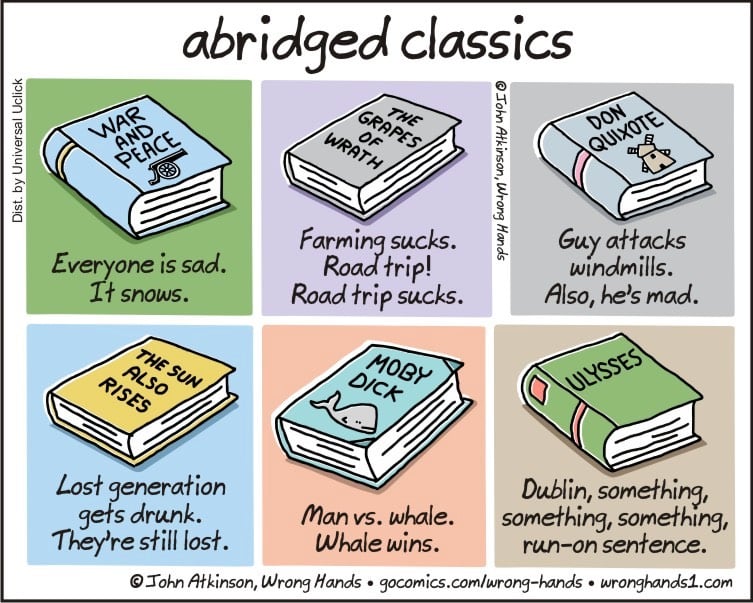
From cartoonist John Atkinson, the plots of some classic books distilled down to just a few words. Like The Grapes of Wrath:
Farming sucks. Road trip! Road trip sucks.
Atkinson followed this up with two additional cartoons: (more) abridged classics and (even more) abridged classics. (via @mkonnikova)
Update: From back near the web’s Big Bang comes Book-A-Minute, which contains ultra-condensed versions of classic books. Here’s the summary of War and Peace:
History controls everything we do, so there is no point in observing individual actions. Let’s examine the individual actions of over 500 characters at great length.
(via @philgyford)
Ian Curtis rides a rollercoaster
You know exactly what’s coming but you still laugh your ass off.
The most significant buildings of the past 125 years

The Architectural Record recently chose the 125 “most significant works that defined architecture” built in the past 125 years. Included are the Morgan Library, the old Penn Station, Frank Lloyd Wright’s Robie House, the Eames House, the Seagram Building (a particular favorite of mine), the Salk Institute, the Memorial to the Murdered Jews of Europe, and the High Line.
The reviewer reviewed
Ian Parker wrote about the NY Times’ restaurant critic Pete Wells for the New Yorker this week.
Wells is generally a well-mannered critic, if not an overly respectful one. In his first years on the job, he was sometimes faulted in the food press for being too generous in his appraisals; he had made a point of publishing fewer one-star reviews than his immediate predecessors. “No one likes one-star reviews,” Wells told me, in a conversation at his apartment, which is in a Clinton Hill brownstone. “The restaurants don’t like them, and the readers don’t like them. It’s very tricky to explain why this place is good enough to deserve a review but not quite good enough to get up to the next level.” He added, “I’m looking for places that I can be enthusiastic about. Like a golden retriever, I would like to drop a ball at the feet of the reader every week and say, ‘Here!’”
Parker covers Wells’ most notable reviews — Per Se, Fieri, Senor Frog’s, Momofuku Nishi — as well as the reactions of the restaurants to the reviews.
“I can’t ever read that review again — I’ll get so fucking angry I’ll die,” Chang said. “I made a lot of that food! I tasted it! It was delicious. And… fuck! I believe in the fucking food we make in that restaurant, I believe it to be really delicious, I believe it to be innovative, in a non-masturbatory way.”
I love David Chang. Never change. But back to Wells, I had a conversation last night with a friend who worked in a restaurant that Wells reviewed and he said that Wells is perhaps not physically suited for undercover restaurant dining — “he’s an odd looking dude” was the quote. And I have another friend in the restaurant industry who, after living in Clinton Hill for a few months, told me, “I think Pete Wells is my backyard neighbor.” Several months later: “Yeah, Pete Wells definitely lives behind me.” We joked about Wells talking over the fence in the style of Wilson, the neighbor in Home Improvement whose face is always partially hidden.
A Valley Girl contest from 1982
This Valley Girl contest that aired on Real People1 in 1982 is quite the time capsule of Reagan-era America. BAG YOUR FACE!!!! I had totally (LIKE, TOTALLY!!) forgotten about that super-80s insult. Is the Valley Girl thing the reason we, like, all say “like” and uptalk all the time now?
Along with the Dukes of Hazzard, Real People and That’s Incredible were my favorite shows in the early 80s. I probably watched this episode on TV when it first aired.↩
The hippest internet cafe of 1995
Opened in 1995 on St. Marks in the East Village, the @ Cafe was one of the first (and coolest) internet cafes in the US.1 They had a bunch of computers, a T1 line (at $9000/mo!), a hip menu including alcoholic beverages, and no idea what they were doing. They didn’t plan for ventilation for all the hardware, so they cooled the server room with a garbage can full of ice!
And I was glad to hear the CU-SeeMe shout out at the very end of the video. I think about that app every time I hear about something “new” like Facebook Live, Periscope, or Snapchat. Talk about being ahead of its time…CU-SeeMe was video chat that predated the popularity of the web.
At the time, very few people even knew what the “@” symbol was. One article featured in the video described it like so: “that @ is pronounced ‘at’ in case you were curious, and it’s often used in e-mails, the way most hackers and computer freaks communicate with one another”. LOL.↩
The colors of friendship
When Ashley was a kid, she was legally blind. Her friends and family described colors to her in a wonderful way.
Yellow. I didn’t touch anything for this, they just told me that whenever you laugh so hard you can’t stop, that that happiness is what yellow looks like.
Green. I held soft leaves and wet grass. They told me green felt like life. To this day it is still very much my favorite color.
I love this list. (thx, nicholas)
The Adjective Word Order We All Follow Without Realizing It
From Mark Forsyth’s The Elements of Eloquence, a reminder of the rules of adjective order that fluent English speakers follow without quite knowing why.
…adjectives in English absolutely have to be in this order: opinion-size-age-shape-colour-origin-material-purpose Noun. So you can have a lovely little old rectangular green French silver whittling knife. But if you mess with that word order in the slightest you’ll sound like a maniac. It’s an odd thing that every English speaker uses that list, but almost none of us could write it out.
The Cambridge Dictionary lists a slightly different order: opinion, size, physical quality, shape, age, colour, origin, material, type, purpose. A poem by Alexandra Teague explores the topic in a creative way:
That summer, she had a student who was obsessed
with the order of adjectives. A soldier in the South
Vietnamese army, he had been taken prisoner whenSaigon fell. He wanted to know why the order
could not be altered. The sweltering city streets shook
with rockets and helicopters. The city swelteringstreets.
Did anyone learn this in school? I sure didn’t. How do we all know then? My daughter’s kindergarten teacher had a great phrase she used when things got a bit tricky as her students learned to read: “the English language is a rascal”. (via @MattAndersonBBC)
Update: Language Log’s post on adjective order is worth reading. (thx, stephen & margaret)
Gene Wilder, Master of the Comedic Pause
Raging Cinema pays tribute to the late Gene Wilder and his use of the comedic pause. On Twitter, Edgar Wright, who knows a thing or two about funny, called for a moment of silence for Wilder:
A moment of silence for the master of the comedic pause.
Gene Wilder: funny doing something & funny doing nothing.
And the Oscar for Best Supporting Weirdo goes to…
Crispin Glover in Back to the Future, Jeff Goldblum in Jurassic Park, and Madeline Kahn in Young Frankenstein are just a few of the interesting and eccentric performances worthy of a Best Supporting Weirdo Oscar.
If Our Bodies Could Talk, a FAQ for human bodies
James Hamblin, the dishy brainiac doctor who does those entertaining and informative videos for The Atlantic, is coming out with a book in December called If Our Bodies Could Talk. He calls it “a FAQ about human bodies”.
Now, in this original and entertaining book, Hamblin explores the stories behind health questions that never seem to go away — and which tend to be mischaracterized and oversimplified by marketing and news media. He covers topics such as sleep, aging, diet, and much more:
Can I “boost” my immune system?
Does caffeine make me live longer?
Do we still not know if cell phones cause cancer?
How much sleep do I actually need?
Is there any harm in taking a multivitamin?
Is life long enough?
Homemade rockets at a Thai rocket festival
In SE Asia, particularly in Laos and Thailand at the start of the rainy season, residents hold rocket festivals at which homemade rocket competitions are held. The device shown in this particular video is lit by a small group of people, who then flee as a massive amount of smoke goes up. And then, well, just watch…I don’t want to ruin what happens for you, it’s wonderful.
Some of these homemade rockets work better than others. (via @sampotts)
Vibrant Kodachrome photos of Harlem Renaissance luminaries





Carl Van Vechten moved to New York in the early 20th century and became “violently interested in Negroes”. As part of that interest, Van Vechten got to know many of the leading black figures in the city and photographed them, first in black & white but later in vibrant Kodachrome. Almost 2000 of his color photos are available at Yale’s Beinecke Library (direct search). Pictured above are Van Vechten’s photos of Ella Fitzgerald, Eartha Kitt, W.E.B. DuBois, Dizzy Gillespie, and a young James Earl Jones. (via the new yorker)
The Ramsophone

This is fun: the Ramsophone is a music box you can play around with on the web. Push buttons to make it do stuff and refresh for a new box that sounds/works differently. Design inspired by Dieter Rams and music inspired by the Stranger Things theme.
Kanye deconstructed: The human voice as the ultimate instrument
Kanye West is not a great singer. But he packs his songs and albums full of the human voice. Estelle Caswell explains how Kanye uses the human voice as the central instrument in his music.
The jump scare
Jump scares are the easiest way for hack moviemakers to get the audience’s blood flowing: a quick cut accompanied by a loud noise. But it’s a cheap trick, more or less the same one employed by tweens to scare hiccups out of each other.1 But as this video shows, jump scares can be employed to serve the plot, heighten tension, and to “make the calm moments of the movie scary”.
P.S. Why are trailers for horror/action/sci-fi/drama movies so terrible? Because they’re all jump scares.
Speaking of quick cuts, a slight hiccups interlude. I’ve never placed much stock in hiccup cures — breathing into a paper bag, a sudden scare, drinking from the opposite side of a glass — but my son had the hiccups a few months ago and after 25 minutes, they just weren’t going away. After combing through various cures online, we settled on trying a spoonful of honey. One swallow and the hiccups instantly vanished. Like *snap*.↩






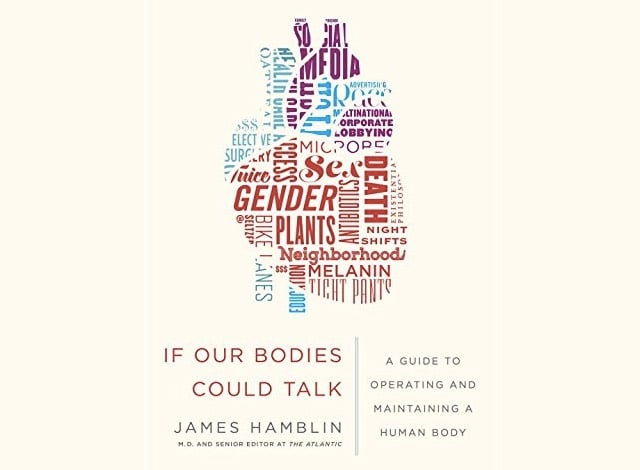
Stay Connected